Having left the Monastery of the Holy Trinity on mount Ovčar, very soon I reached a wide trail that led through the forest. Now, this was an easy walk and I must admit that I enjoyed thoroughly. Here is a brief video:
Needless to say, there were a lot of wild flowers here as well.
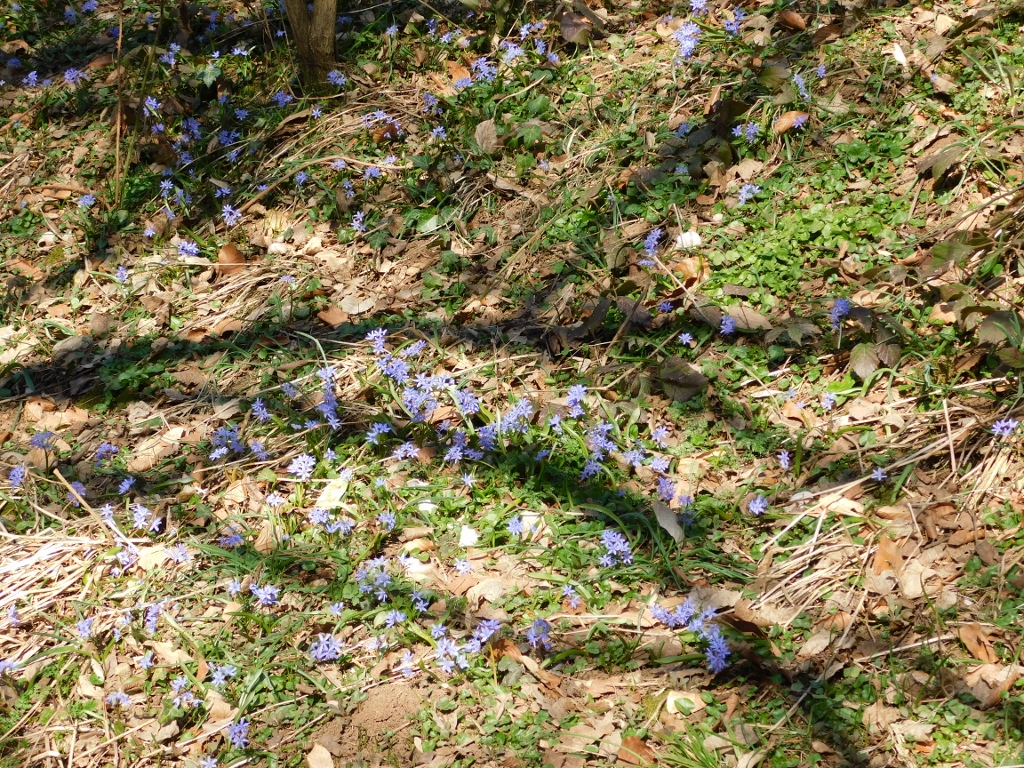 Alpine squill (Scilla bifolia)
Alpine squill (Scilla bifolia)
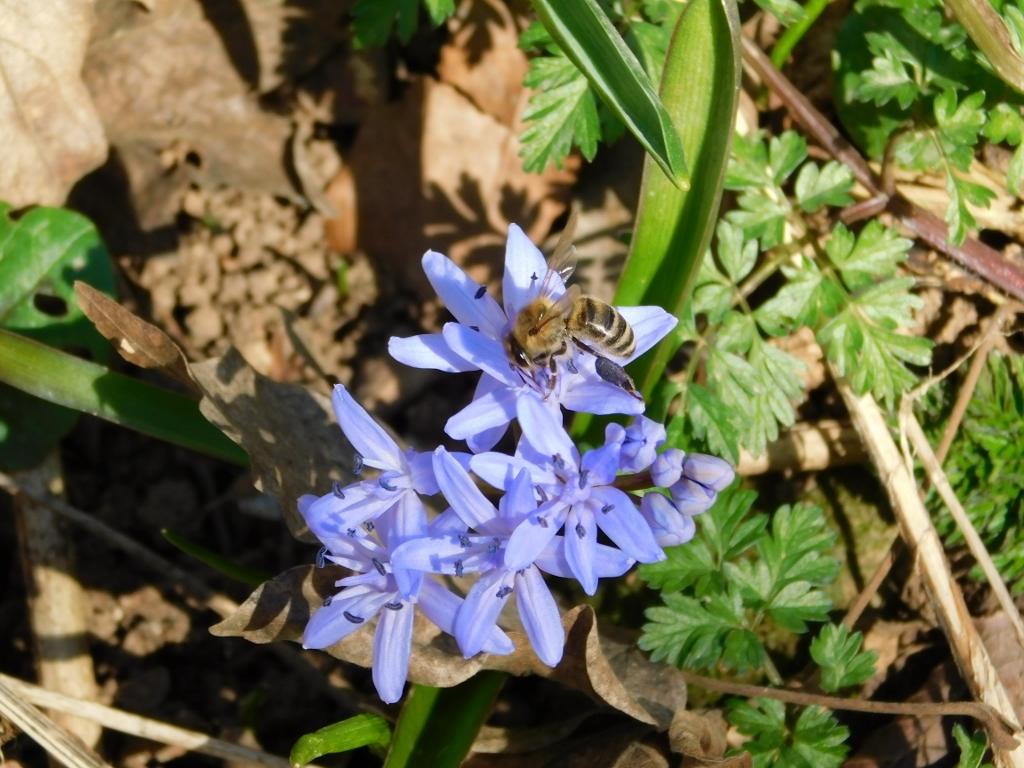 Alpine squill (Scilla bifolia)
Alpine squill (Scilla bifolia)
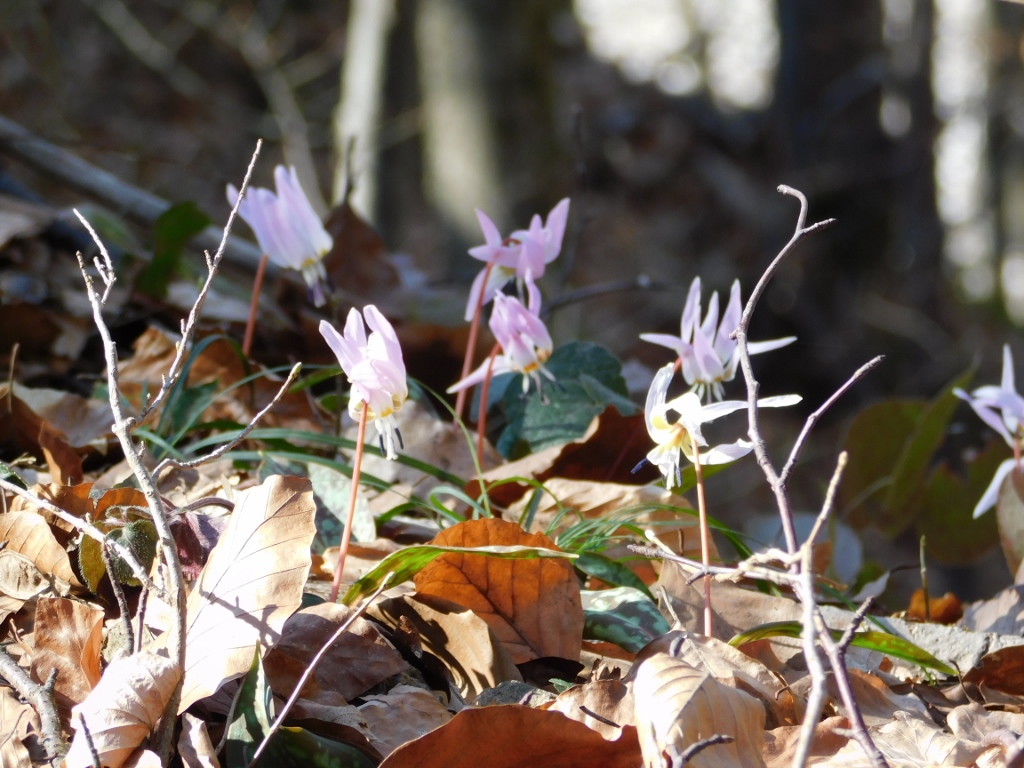 Dogtooth violet (Erythronium dens-canis)
Dogtooth violet (Erythronium dens-canis)
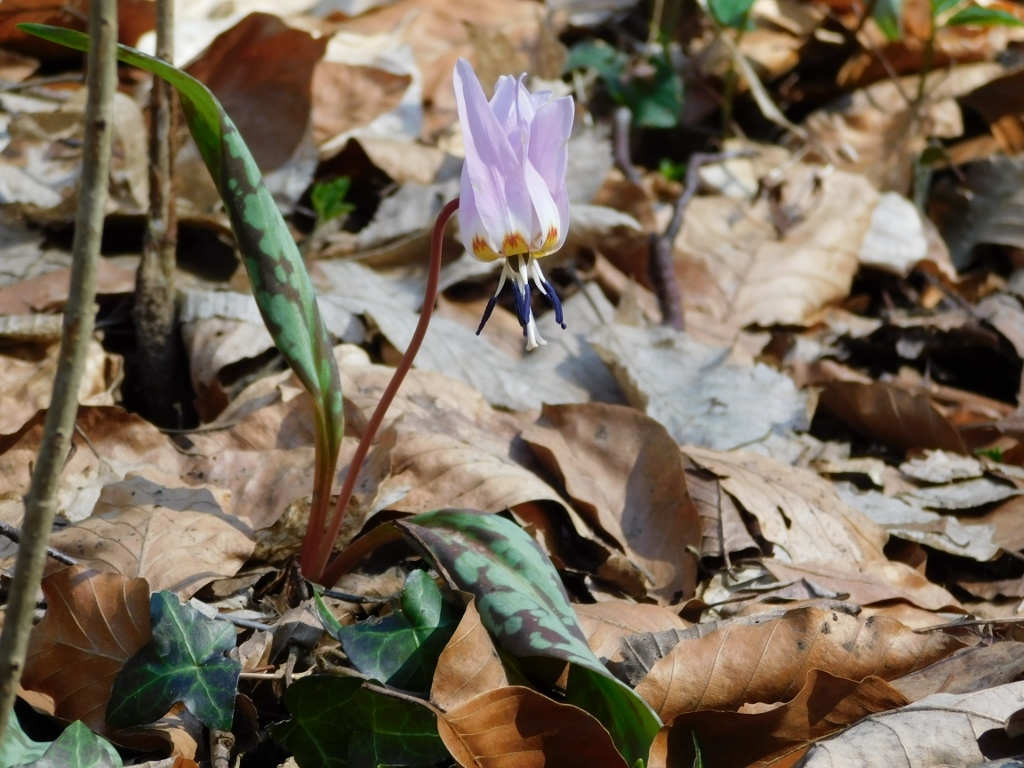 Dogtooth violet (Erythronium dens-canis)
Dogtooth violet (Erythronium dens-canis)
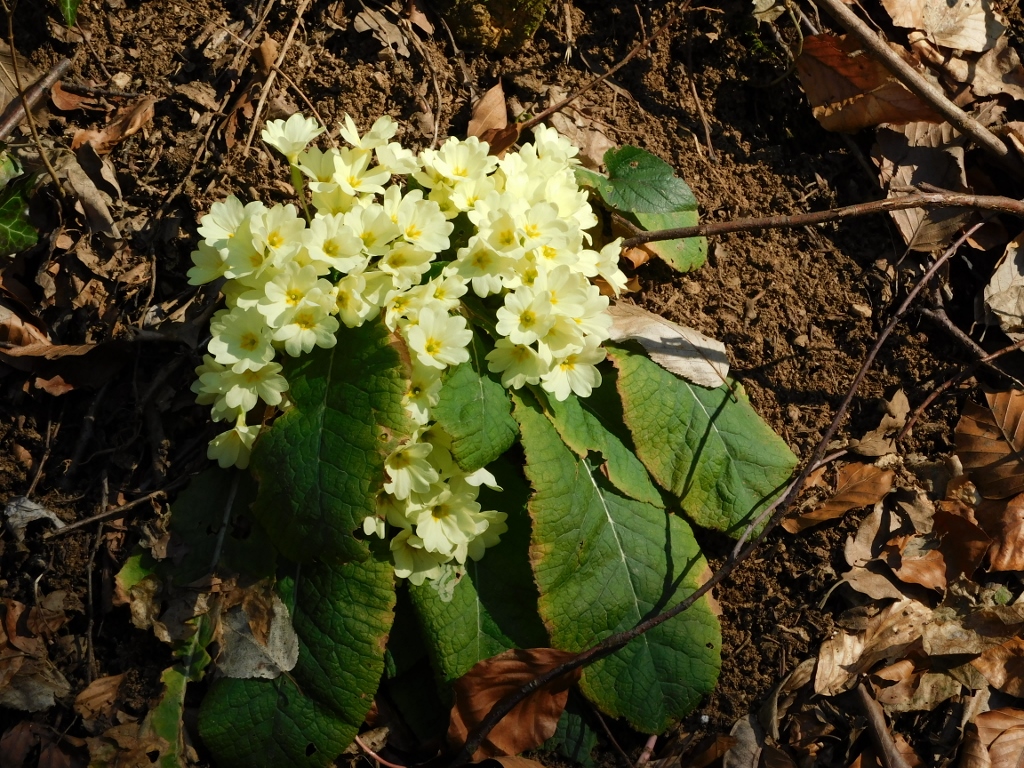 Common primrose (Primula vulgaris)
Common primrose (Primula vulgaris)
At some point, I simply sat down on the dry leaves that covered the slightly elevated earth by the trail and I made a break there in order to have a sandwich I made that morning. There was so much common primrose in that place that I was surrounded by it while I ate.
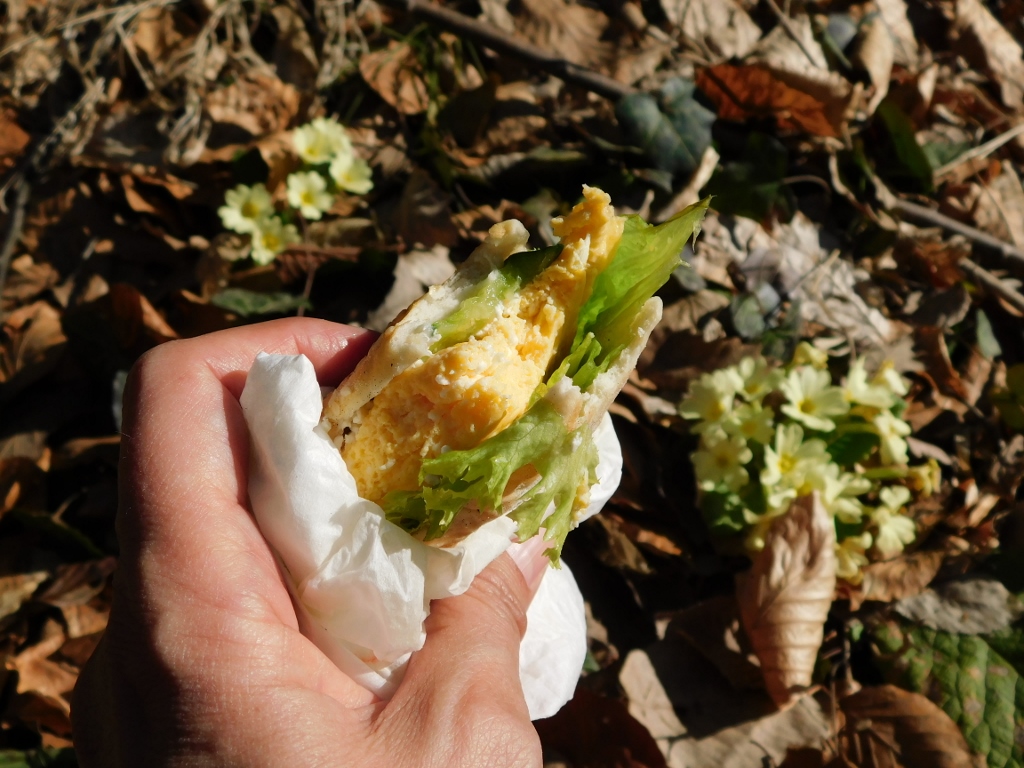 Le Déjeuner sur l’herbe
Le Déjeuner sur l’herbe
After some time, I needed to cross a water stream, but that was not an issue, so soon I could see parts of Ovčar Banja.
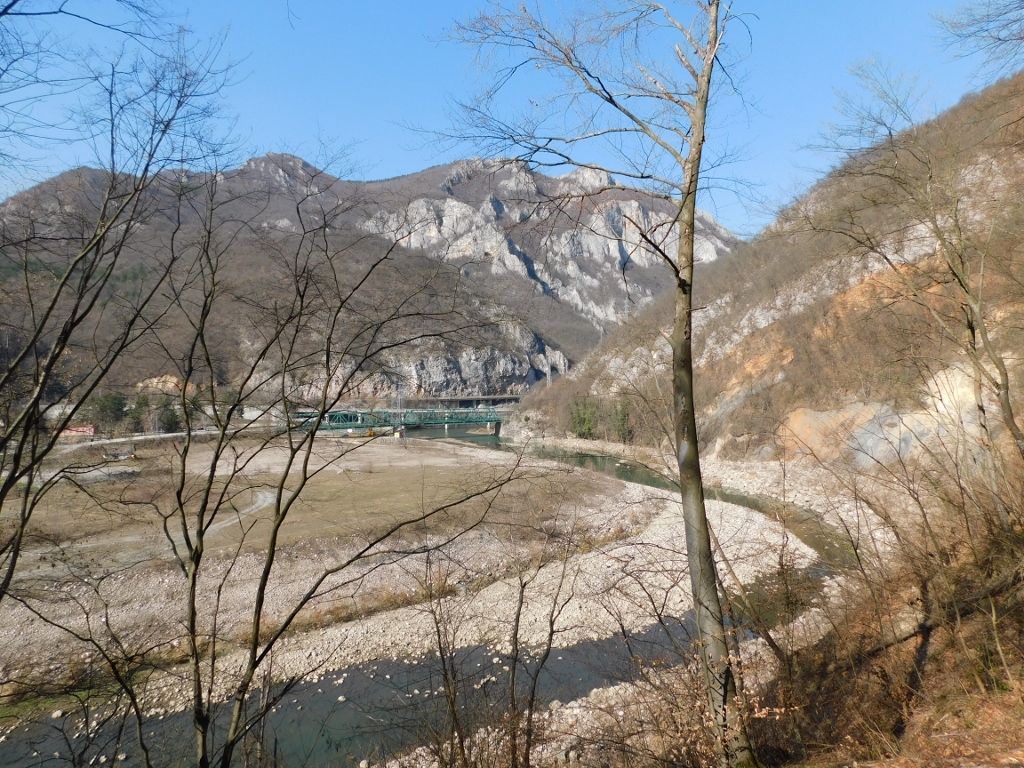 The Zapadna Morava, the green bridge leading to Ovčar Banja and mount Kablar in the distance
The Zapadna Morava, the green bridge leading to Ovčar Banja and mount Kablar in the distance
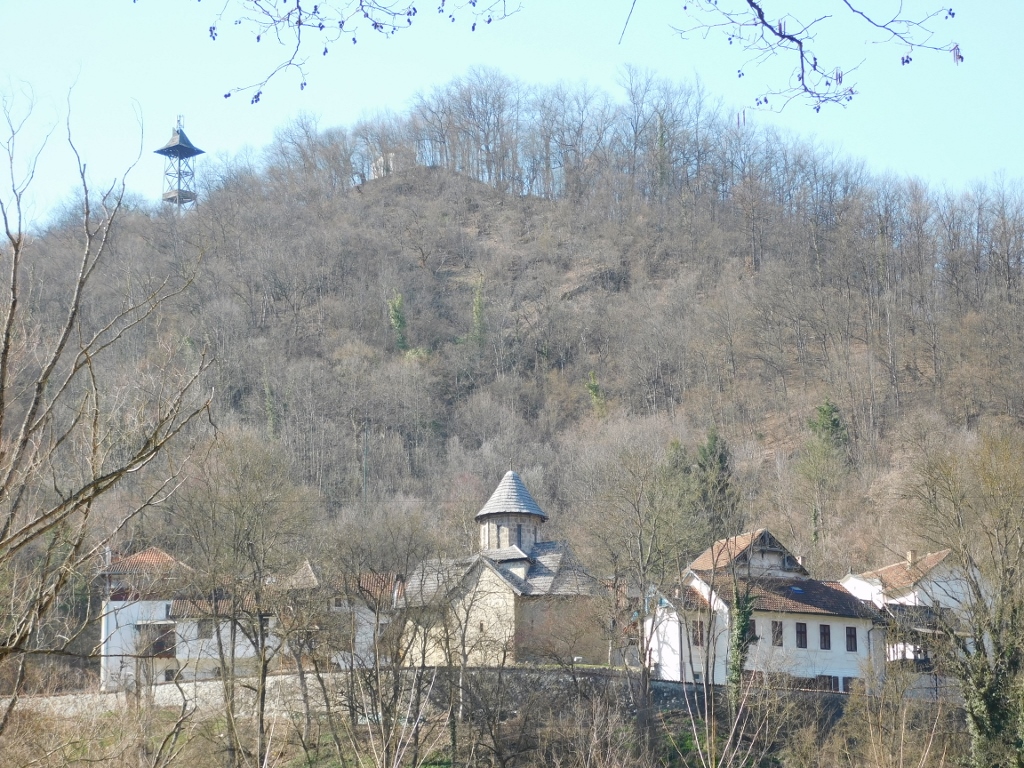 Monastery of the Annunciation in the foreground and the Monastery of St. Elijah on the top of the hill
Monastery of the Annunciation in the foreground and the Monastery of St. Elijah on the top of the hill
Here the trail passes through some kind of a settlement consisting of holiday homes and there is also a trail leading to the Church of Kađenica that also belongs to the Ovčar-Kablar monasteries and is under the administration of the Monastery of the Transfiguration, but I did not have enough time to visit it on this occasion, so I did not go there.
 Monastery of the Annunciation (left), Kablar (middle) and slopes of Ovčar (right)
Monastery of the Annunciation (left), Kablar (middle) and slopes of Ovčar (right)
First I went directly to the hotel in order to leave those things that I bought at the monasteries, in order to make it easier for me to continue with the sightseeing.
 Ovčar Banja – Kablar is to the left and Ovčar is to the right
Ovčar Banja – Kablar is to the left and Ovčar is to the right
From the hotel that is on the right-hand side of the Zapadna Morava canal by which the water from the hydro-electric plant in Ovčar Banja comes I crossed to the left-hand side walking along a path that follows the line of the exit from the water tunnel.
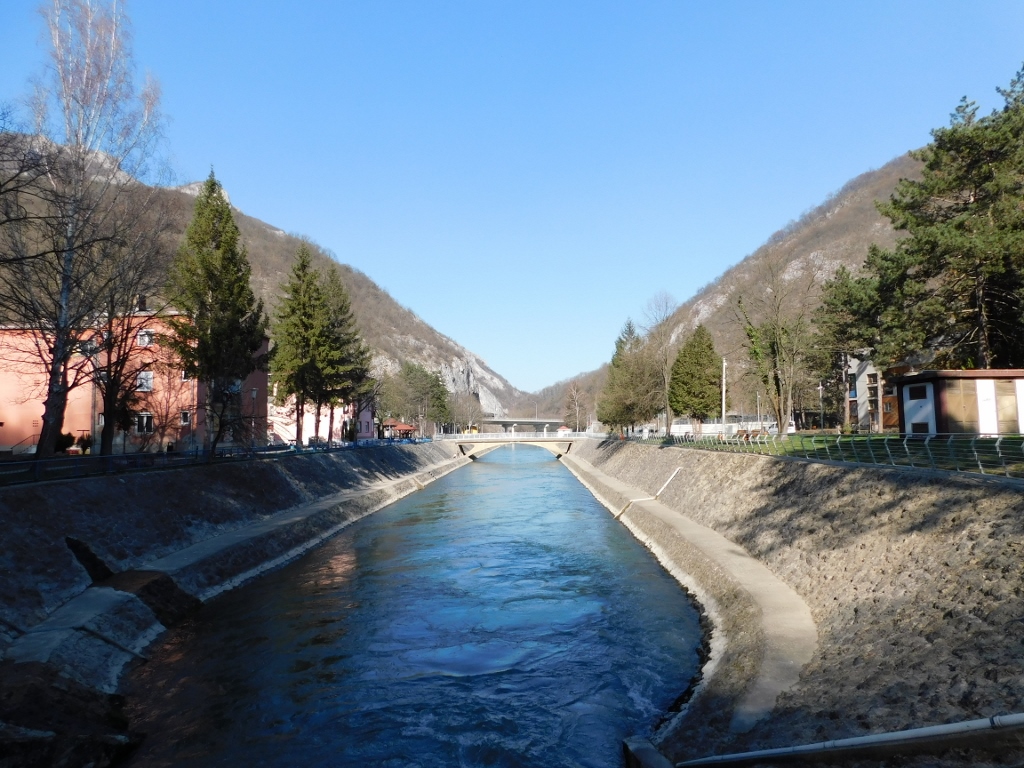 View at the Zapadna Morava canal from the path going around the exit from the tunnel
View at the Zapadna Morava canal from the path going around the exit from the tunnel
There are numerous water springs in Ovčar Banja, as well as on the surrounding mountains. Some of them are thermal, some of them are ordinary. I’ll say a few words about the thermal waters of the spa a little later, but now here is a photo of a spring with potable water in the spa itself.
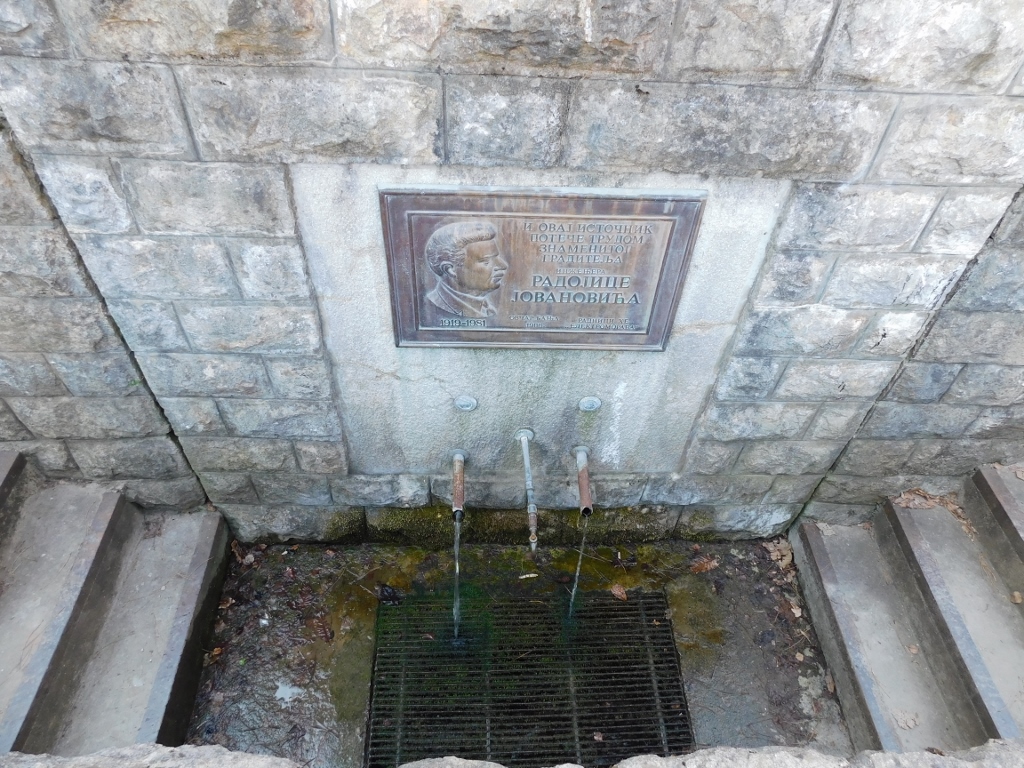 Potable water spring in Ovčar Banja
Potable water spring in Ovčar Banja
Now I headed for the Monastery of the Annunciation. Once, back in the day, when I was at the spa with hikers, it happened somehow that there was not enough space at the mountain lodge and we did not have money for a hotel, so we asked, were granted a permission and then we slept at the dormitory of the Monastery of the Annunciation. That was a true Christian thing to allow “lost” travellers to spend the night there.
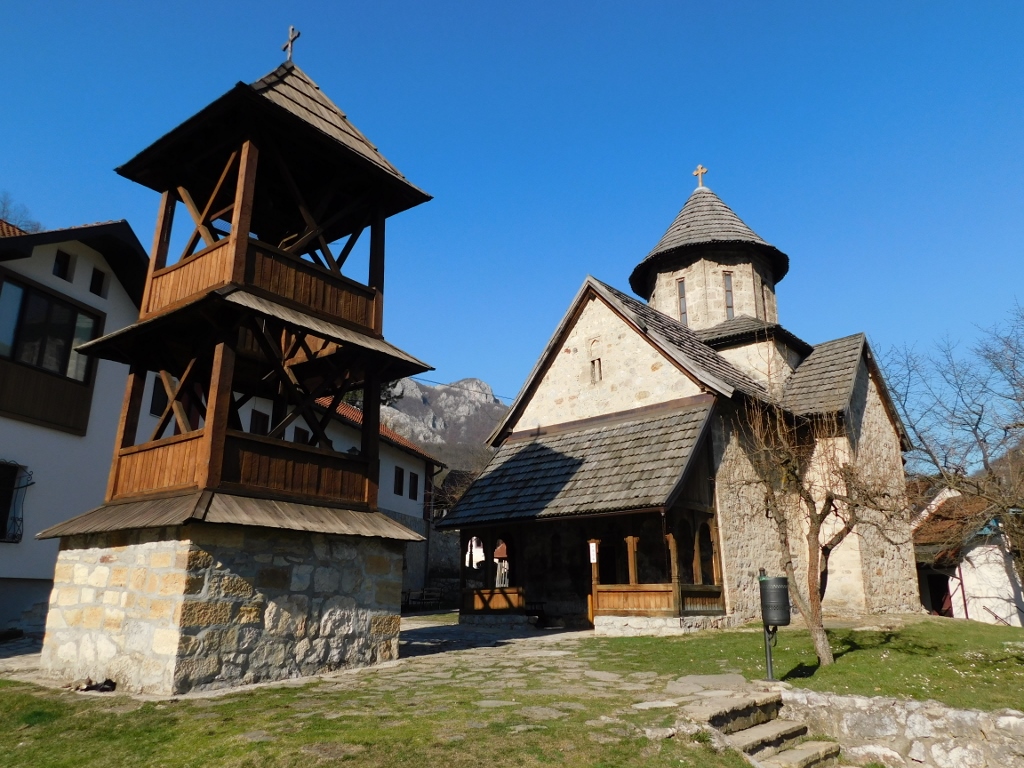 Monastery of the Annunciation in Ovčar Banja
Monastery of the Annunciation in Ovčar Banja
This monastery is a cultural property of great importance. Although some architectural elements may suggest that it was built in the 12th or the 13th century, there is an inscription above the entrance door saying clearly that the year of construction is 1602. The monastery was fresco-painted in 1632 and it was known for its transcribing activity. It was precisely such activities which despite some interruptions went on for centuries in all of these monasteries in the Minor/Serbian Mount Athos, thus ensuring the duration not only of spirituality, but also of literacy and creativity, that make these monasteries so significant for the Serbian history and culture.
The ground plan of the church at the Monastery of the Annunciation has the shape of a cross. The apse is in the east, while in the west, with the entrance door, a porch with wooden pillars has been recently added. The dome includes an eight-sided drum which I took a photo of later, when going to the Monastery of St. Elijah. It can be seen much better from that side than from the yard.
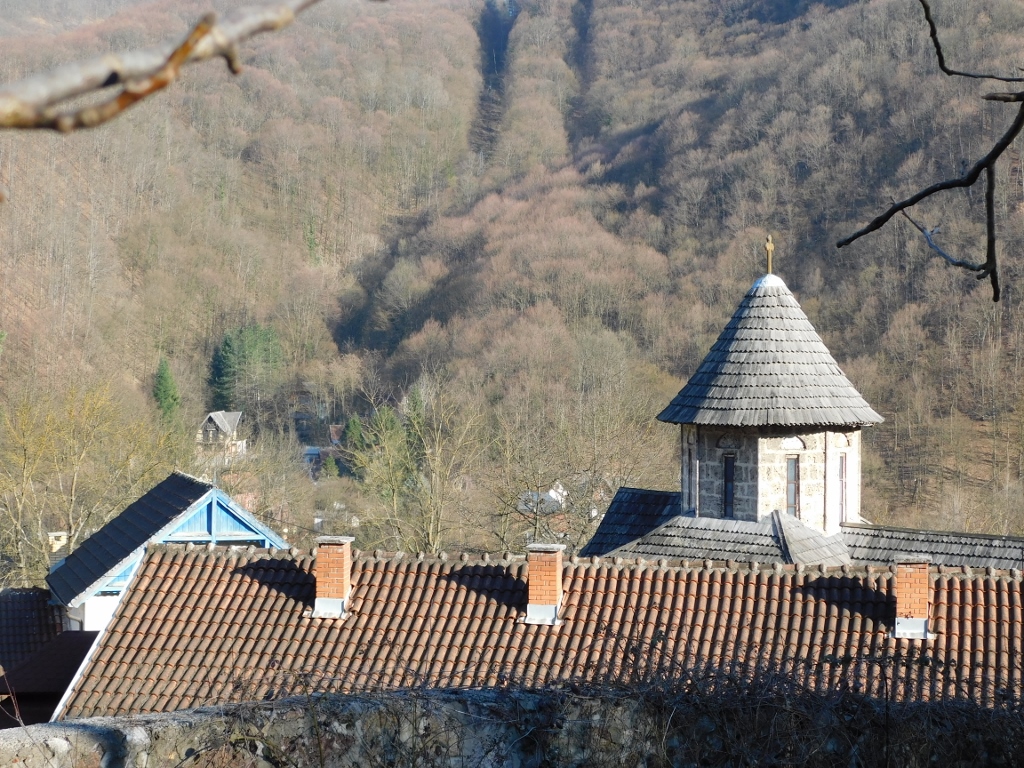 Monastery of the Annunciation in Ovčar Banja
Monastery of the Annunciation in Ovčar Banja
The experience when I entered the church was impressive and it seemed to me that these frescoes were the most beautiful that I saw in the Ovčar-Kablar Gorge. But, photography is strictly forbidden inside. Still, it is permitted to take photos outside, which helps get an impression about the beauty of the frescoes inside the church, since the entrance porch, among other things, protects the frescoes that exist on the front facade of the church.
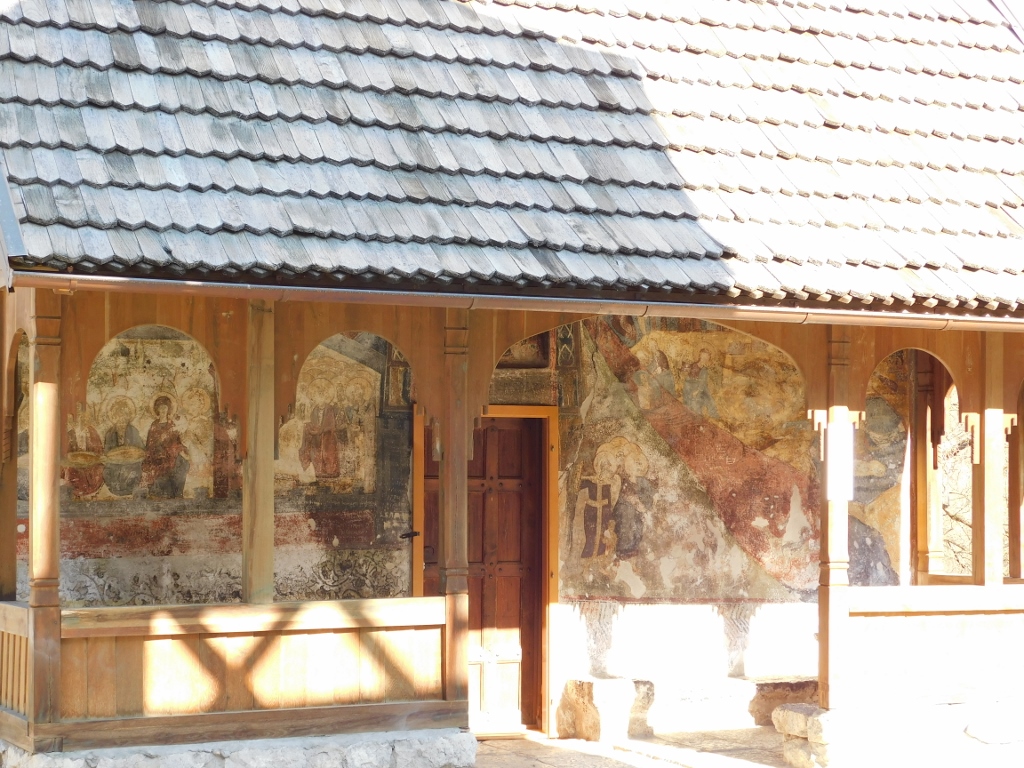 Monastery of the Annunciation
Monastery of the Annunciation
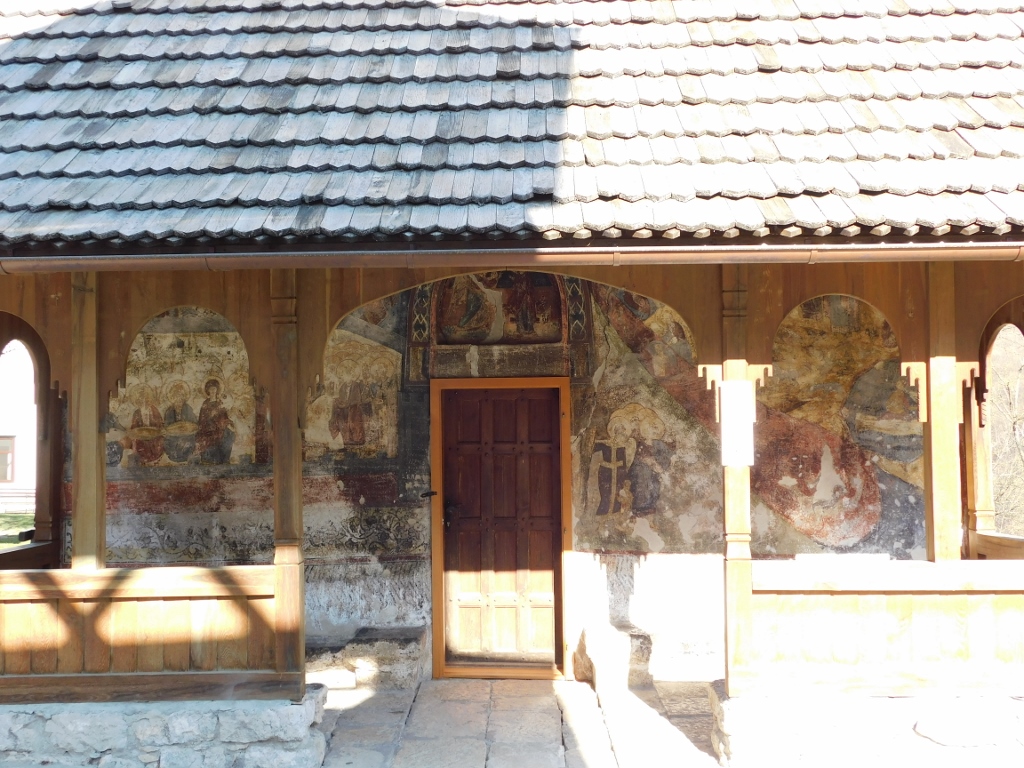 Monastery of the Annunciation
Monastery of the Annunciation
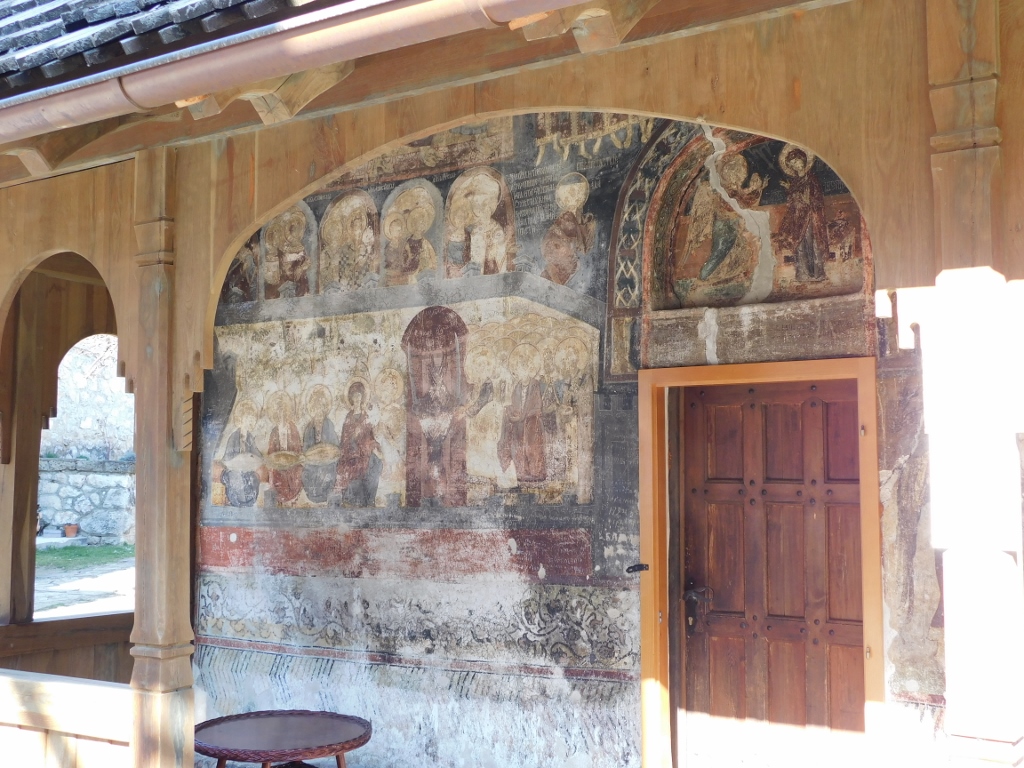 Monastery of the Annunciation
Monastery of the Annunciation
From here I continued to go uphill and at some point I came across a large surface covered in sweet violets (Viola odorata). Note a couple of European firebugs (Pyrrhocoris apterus) that were wandering around, while in the first photo there is also a bee.
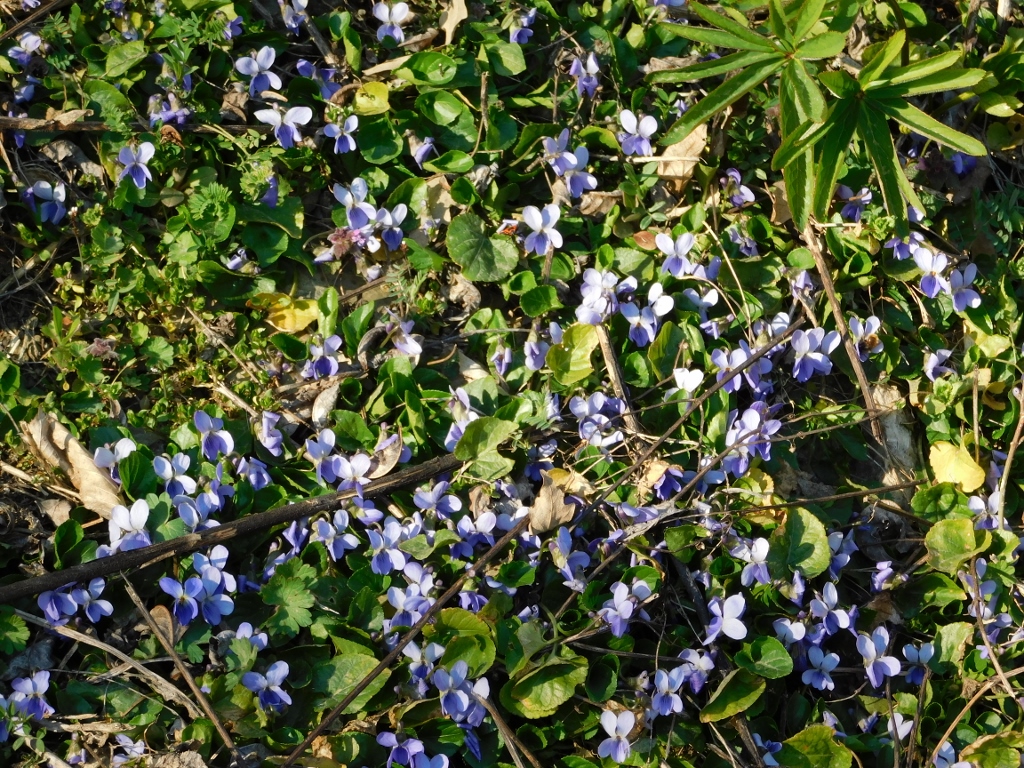 Sweet violets
Sweet violets
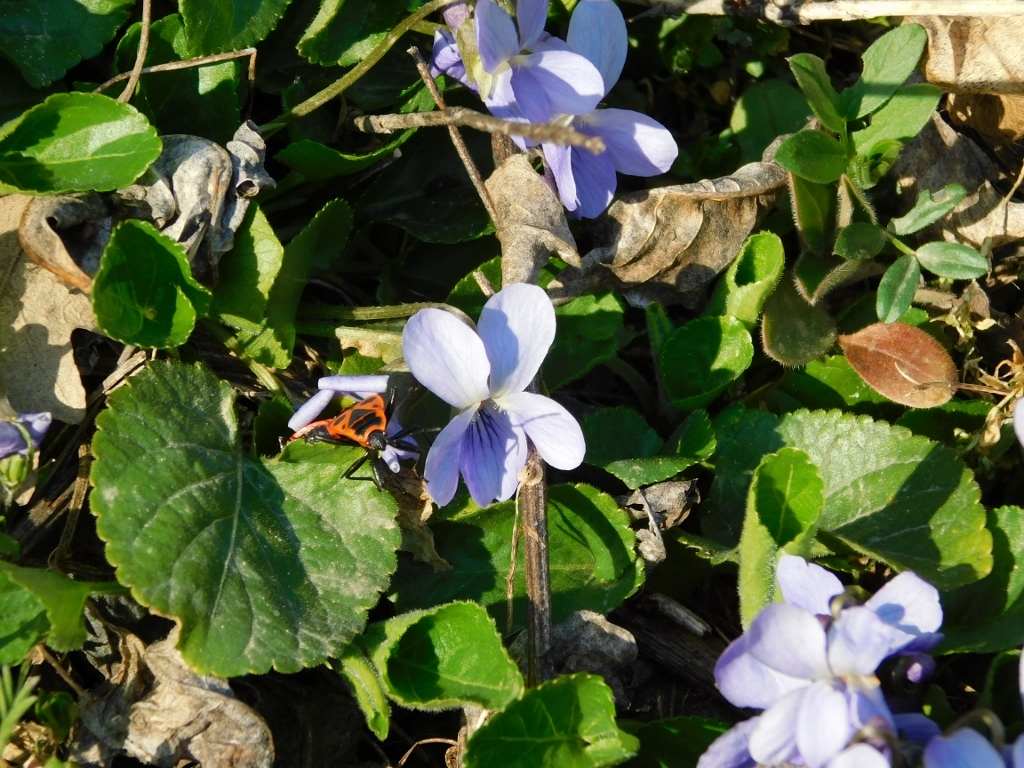 Sweet violets and a European firebug
Sweet violets and a European firebug
After the uphill hike, I saw the Monastery of St. Elijah.
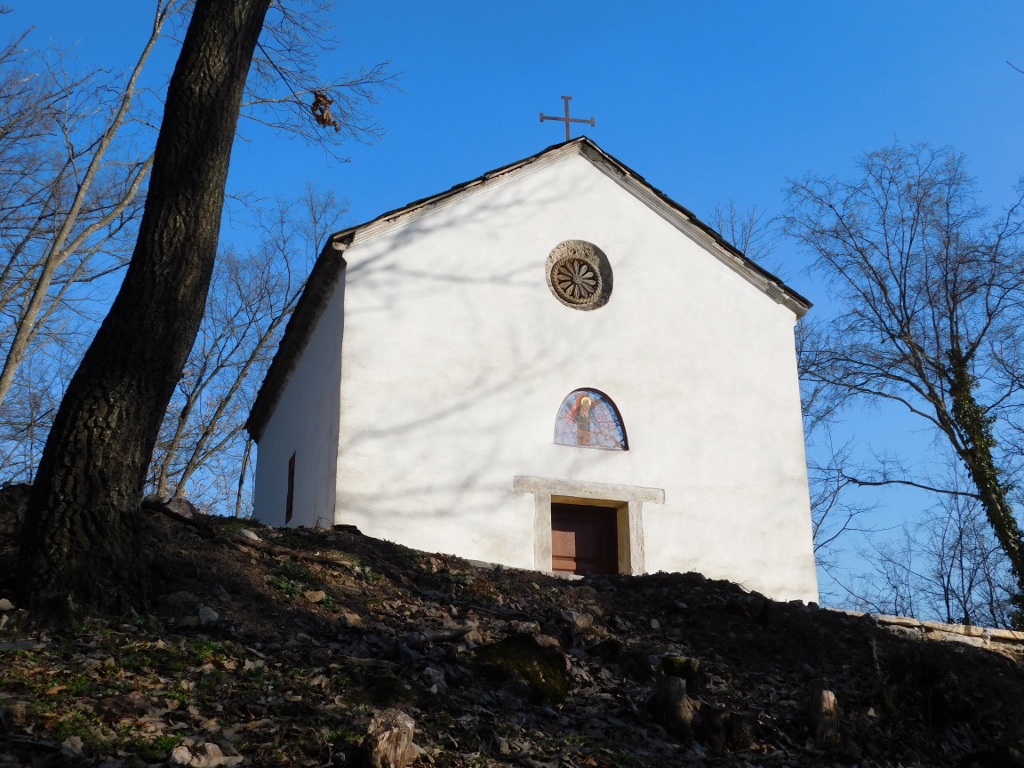 Monastery of St. Elijah
Monastery of St. Elijah
The monastery is dedicated to the Holy Prophet Elijah and it was first built by the monks from the Monastery of the Annunciation as their metochion. The time of its construction is not known accurately, but on the basis of the foundations it has been established that the original church was larger than the one that can be seen here today. The present-day church was restored in 1939 thanks to Bishop of Žiča Nikolaj Velimirović who was instrumental for the restoration of several other monasteries which I have already written about.
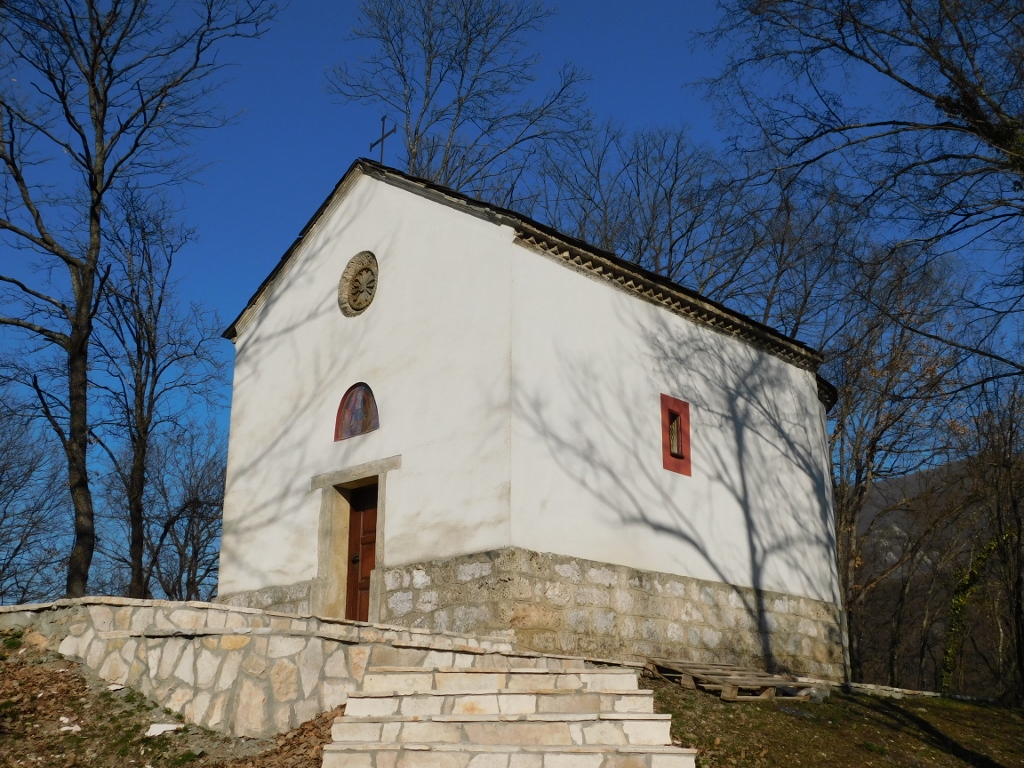 Monastery of St. Elijah
Monastery of St. Elijah
This is a simple single-nave and quite lovely church. The door was closed, but not locked, so I entered. The iconostasis was the gift from the Bishop himself.
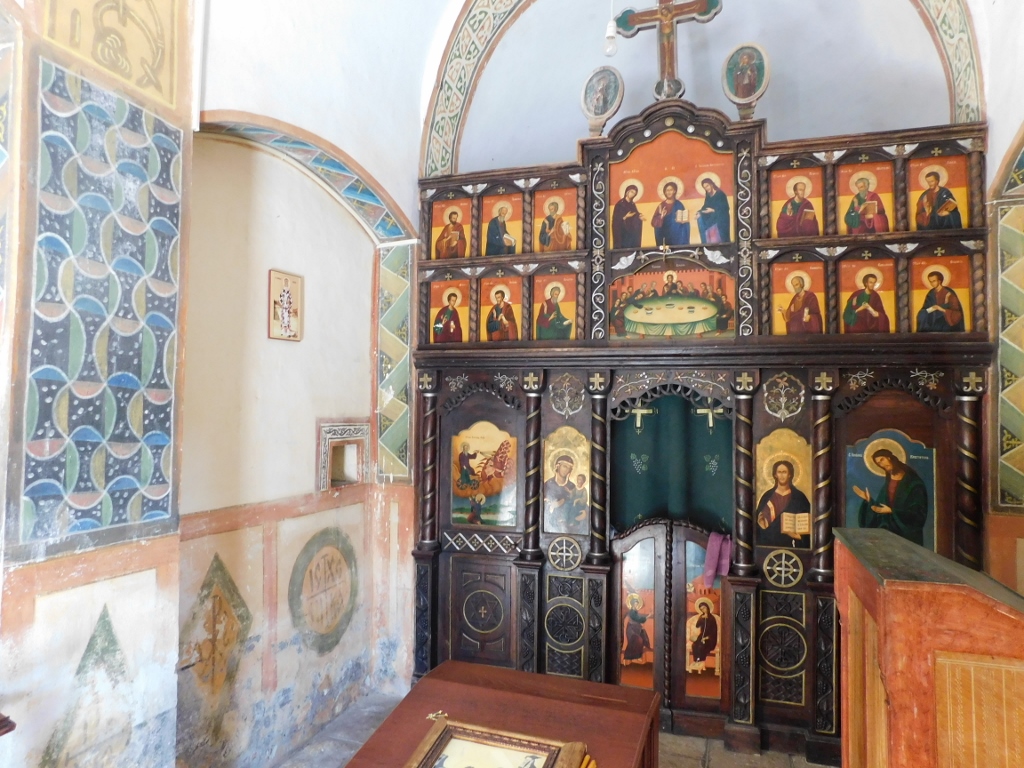 Monastery of St. Elijah
Monastery of St. Elijah
Because of the Sun in the late afternoon, it was difficult for me to take a proper photo of the wooden tower that is opposite the church, but I did it comparatively well from the interior of the church.
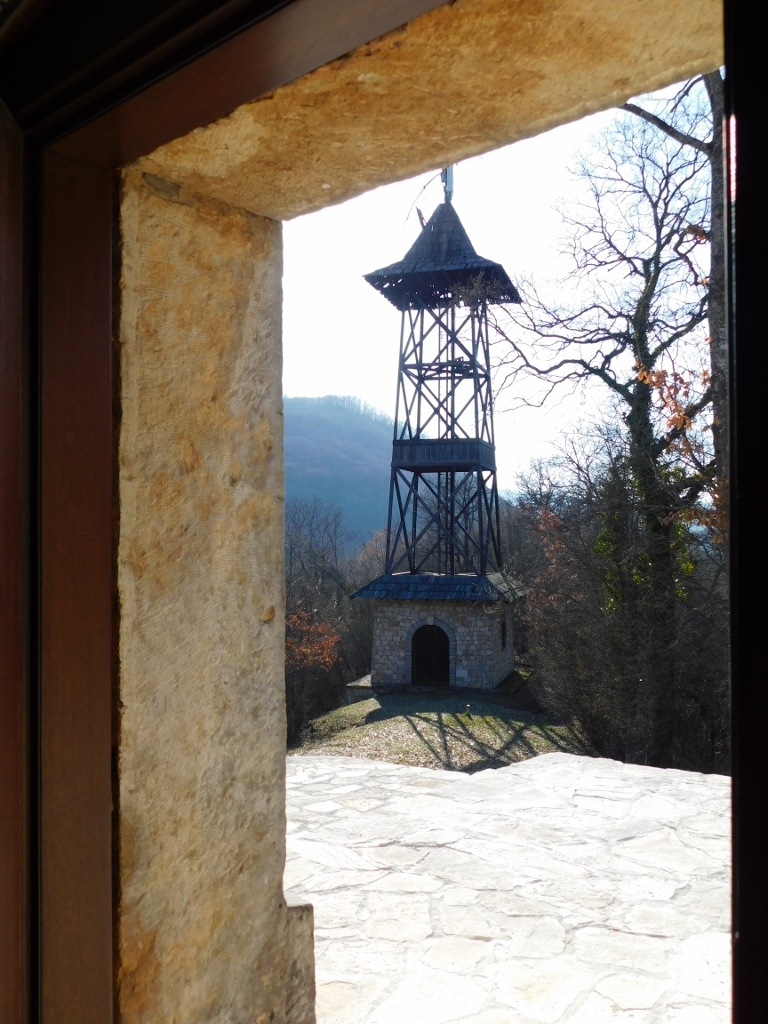 Monastery of St. Elijah, a detail
Monastery of St. Elijah, a detail
Once I had finished with the proper sightseeng at the interior decoration, I went out of the church, closing the door behind me, and I also took photos of the mountains that I walked across these days.
 Mountains Kablar and Ovčar, while the Monastery of St. Elijah is to the right
Mountains Kablar and Ovčar, while the Monastery of St. Elijah is to the right
Very much content with what I did and visited this day, I slowly went back to the spa and the hotel. The hotel has a pool with the spa’s thermal water, so I decided to go for a “therapy.” It felt wonderful to enter the homeothermic water in the pool where I found a suitable place, grabbed a pole at the edge of the pool and spent the next half an hour floating and swaying in the water letting it do whatever was necessary. Because the thermal water from Ovčar Banja is known for its therapeutic features, especially when it comes to rheumatism and skin problems. I don’t have any of these to any significant degree, but... One can never have too much of a good thing!
My plans for the last day of this trip did not include any walking, so I decided to spend a lazy first part of the morning. Since the hotel offered this pool with thermal spa water, I thought this would be good for the beginning of the day.
Afterwards I went for a late breakfast and then I could slowly start going back home, but making a proper wide circle in order to visit a few more monuments of culture that exist in this area.
First I followed the old road along the left bank of the Zapadna Morava river. As I had decided a couple of days earlier, when I went through the longer tunnel I have already written about, I immediately took a turn towards the monasteries in that area and drove up to the top of the hill and the Monastery of the Assumption of the Theotokos.
However, there I encountered a locked gate and a very clear piece of information which said that “the monastery is of a closed type and is not open to any kind of tourism.” Believers may come on Sunday morning, during the service, but that was all. I had already realised that each monastery had its own rules, so I just took a photo of what I could see from the parking lot.
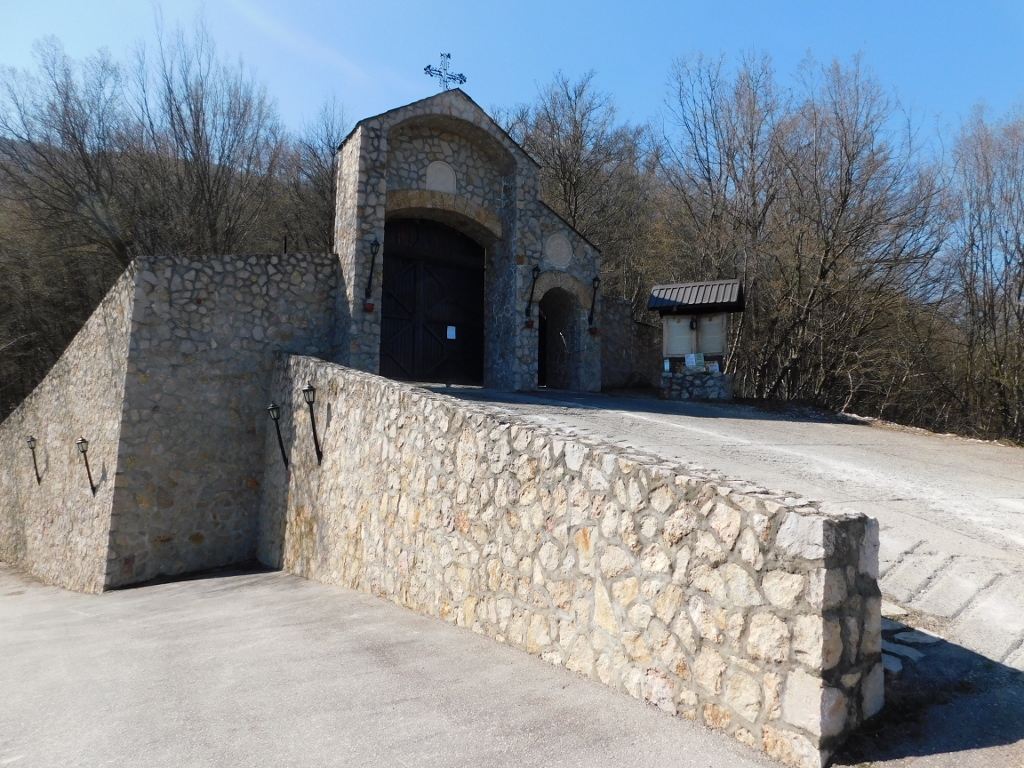 Closed entrance to the Monastery of the Assumption of the Theotokos
Closed entrance to the Monastery of the Assumption of the Theotokos
Still, let me just say that the Monastery of the Assumption of the Theotokos is the youngest in the Ovčar-Kablar Gorge. It was first mentioned in the Ottoman sources in 1536, but it suffered a lot over time. This monastery, too, was restored by the Bishop of Žiča Nikolaj Velimirović in 1939. However, after WWII, the monastery was deserted and its renewal started only towards the end of the 20th century. Finally, the monastery was consecrated in 2005. The monastery church is very interesting since it consists, in fact, of two smaller churches connected by a joint narthex. The left part is dedicated to the Assumption of the Theotokos, while the right part is dedicated to the Seven Holy Martyred Youths of Ephesus.
Since there was nothing I could see here apart from the entrance gate, I got into the car and moved on, but only to a place from which it is possible to see a meander of the Zapadna Morava from up close. There is, of course, a viewpoint higher up, but one needs to walk there. On this day, there were no such activities foreseen for me, plus I did not have the time, so it sufficed to take a photo of the Zapadna Morava from the level of the road.
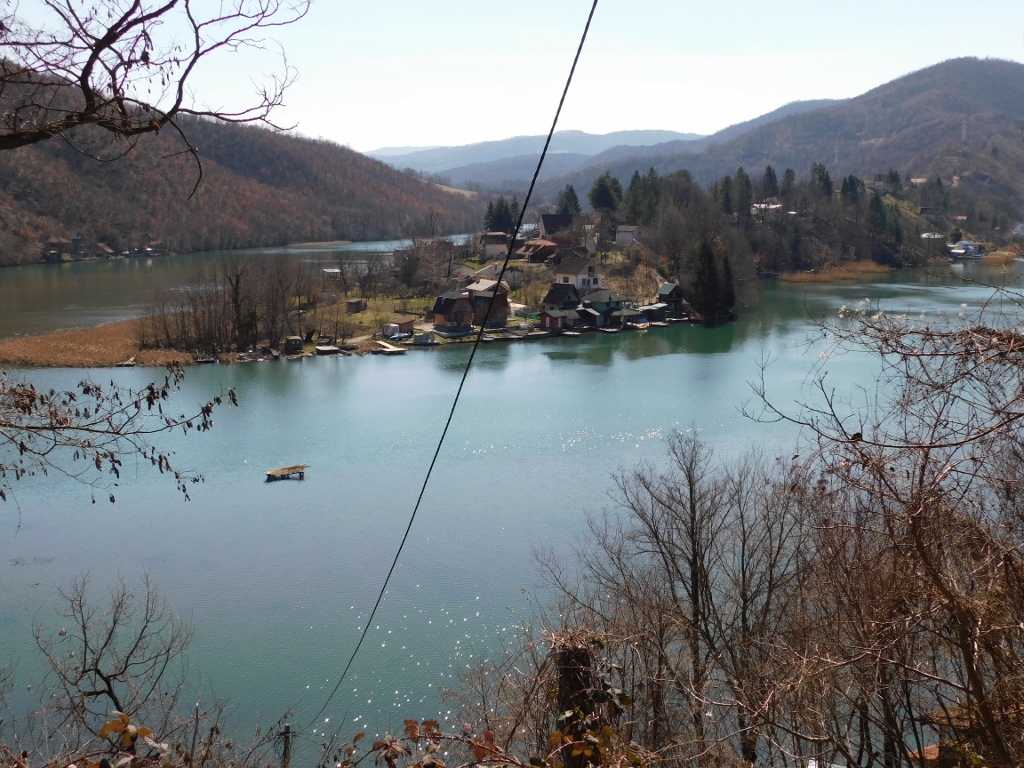 View at the Zapadna Morava from the old road to Ovčar Banja
View at the Zapadna Morava from the old road to Ovčar Banja
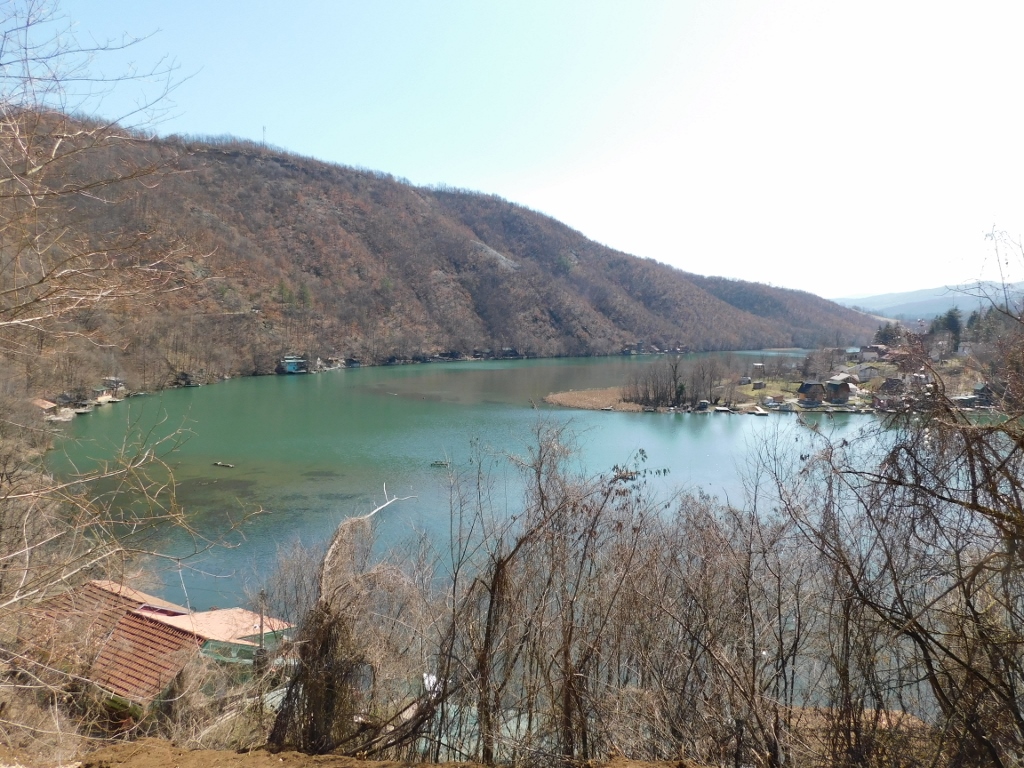 View at the Zapadna Morava from the old road to Ovčar Banja
View at the Zapadna Morava from the old road to Ovčar Banja
My plans for this day were linked to the quest for cultural properties that are located in the villages northwest of Čačak. The first monument of culture in my list was the House of Lazarević (Lazarevića čardak) in village Prijevor from the first half of the 19th century. I knew that this house was near the Church of St. George, the Great Martyr, but not where exactly, so I parked by the church. I came across a few men there taking coffee in a small house opposite the church, so I asked them about the House of Lazarević.
As it turned out, a brother of one of these men was interested in this house back in the day and has apparently left a few dozen photos, but the owner of the house was not interested in the preservation of this house, which was not regularly maintained either, so there were damages on it. This was followed by the earthquakes of 2007 and 2010, and after the major rainfall of 2014, the house was completely destroyed. In other words, there is nothing left there.
I felt sorry, but there was nothing I could do, so I just asked that kind man how to get to village Miokovci, but following direct local roads, rather than driving round and round. As a fine coincidence, one of the men had to go in that direction, so I gave him a lift. It was mutually beneficial. He got out of the car soon, while I continued to the main road that runs through village Miokovci.
I was looking for two old houses there that are cultural properties, but where is one to find two old houses among numerous agricultural holdings in a village that spreads across several hillocks? Well, one has to be positive and relaxed, and let the Universe does its share. And so, driving slowly along this main road in the village, I noticed the motorbike of the local postman who was just doing the delivery at a house. I parked nicely, got out of the car and said to the postman: “You are precisely the man I need!”
He was confused for a second, but then I explained to him what this was all about and which estates I was looking for (I knew the surnames of the families). He was not quite sure, for there are several families with these surnames in the village, but then we were joined by a man from an estate across the road and then the three of us deliberated which way I should go. Then appeared a woman from another house across the road and then the three of them got to the conclusion which holdings this was all about. But, I was yet to get there, while having no clue how to do it. Then the postman said I should follow him. He interrupted briefly his delivery of the mail, got onto his motorbike, while I drove behind. Once we had passed the local cemetery, he stopped, showed me where I should turn and described again which holding I should go to, i.e., where I should turn next. I thanked him and moved on, while he went back to the place where he stopped with his work.
I must say that I really love my nation and our readiness to help others. Needless to say, this is particularly valid when one speaks the language. I’m not sure how some foreigners would get around like me, but I KNOW that the Serbs would try to help them, too.
I got to the entrance into a spacious yard of an evidently well-off agricultural holding and I parked my car there, but I did not see anyone. I entered and headed for the houses (there were two new ones surrounded by auxiliary buildings) hoping to encounter someone and ask about that old house I was looking for. There was no one. I started going back slowly, but right then, the owner came by his car. I greeted him apologising for entering the estate, but I also explained to him who I was and what I was looking for. He showed me exactly where that house was (within the neighbouring holding) and told me that the current owner had just returned from hospital and that he was lying at his home, but that I should feel free and enter the yard. “Oh!,” said I. “I will certainly not disturb anybody. I just want to take a photo of the house.” And so I did.
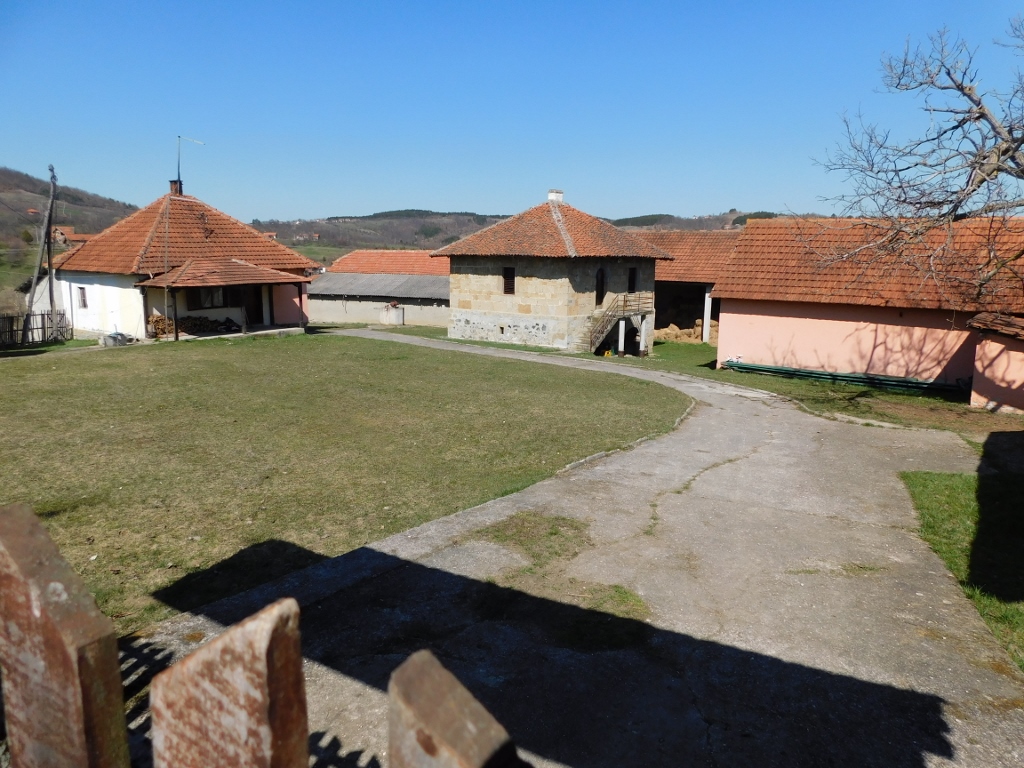 House of Radovanović is in the middle
House of Radovanović is in the middle
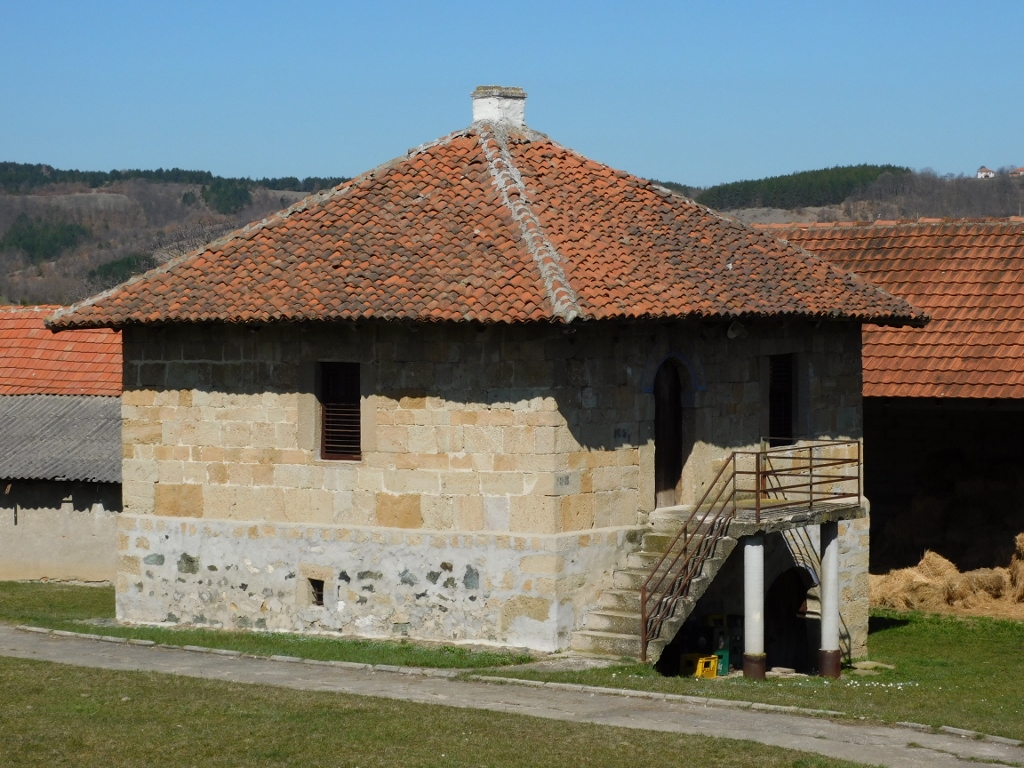 House of Radovanović
House of Radovanović
The House of Radovanović (Kuća Radovanovića – the official name) was built in 1866 and it is a monument of culture. It has a regular square ground plan, a high cellar and an upper floor, while it was made of stones and bricks. As far as I could gather from my materials, the bricks were used on the interior side of the upper floor. The roof is covered with Monk and Nun roof tiles. The entrance into the cellar is reminiscent of church portals, but I could not see that since I did not want to enter the yard and get closer to the house, although it can be seen that the entrance to the floor also has an arched top. Over time, the house underwent certain alterations, including also the construction of a concrete staircase that can be seen in the photo.
On my way to this yard and back I admired the beautiful, tame landscapes through which I walked, full of fruit trees.
 Village Miokovci, a detail
Village Miokovci, a detail
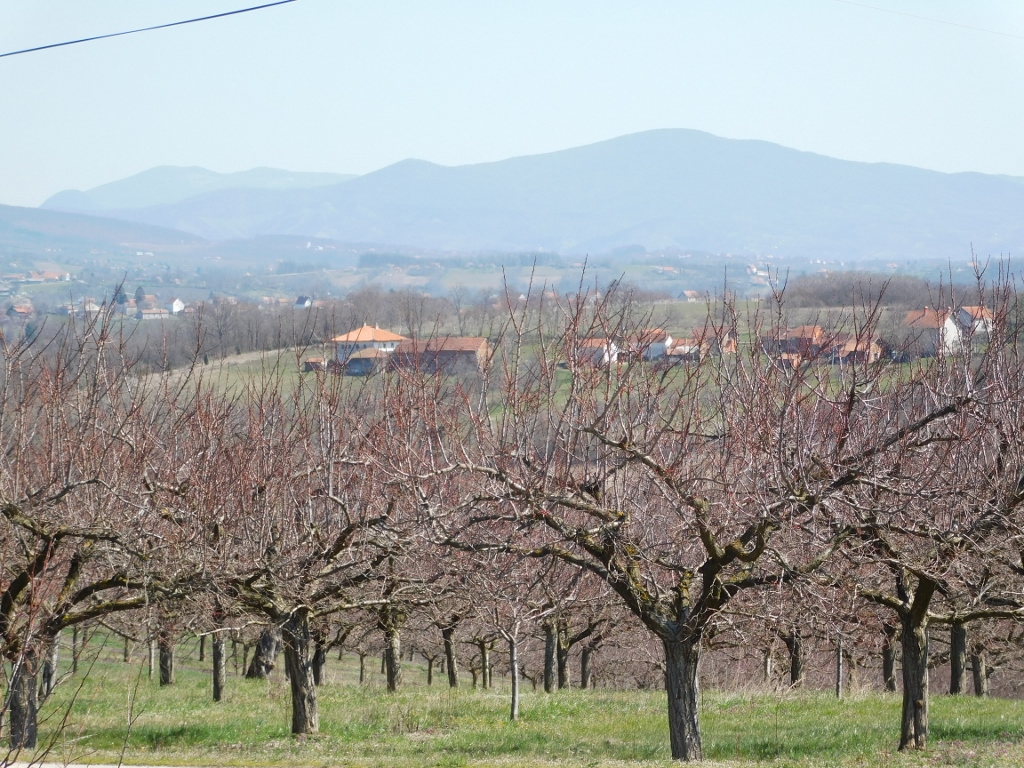 Village Miokovci, an orchard is getting ready for the new season
Village Miokovci, an orchard is getting ready for the new season
When I finished with the photo-taking, I went back to that kind, younger man, thanking him for the help. We chatted a little bit and then he also explained to me where exactly I should go now in order to get to the next cultural property which was in fact less than 1 km away from where I was. That other one was the House of Lužanin (Lužanina kuća). Still, if I hadn’t asked some more along the way, I would have had major difficulties in locating it. For any future visits, I have put into my map the exact points where the houses I was “discovering” during this trip are. Namely, in this case, one has to get off the main road, drive to a fork and then take the left road. Here is the map once again:
The House of Lužanin is a cultural property of great importance and it is situated within a well maintained holding.
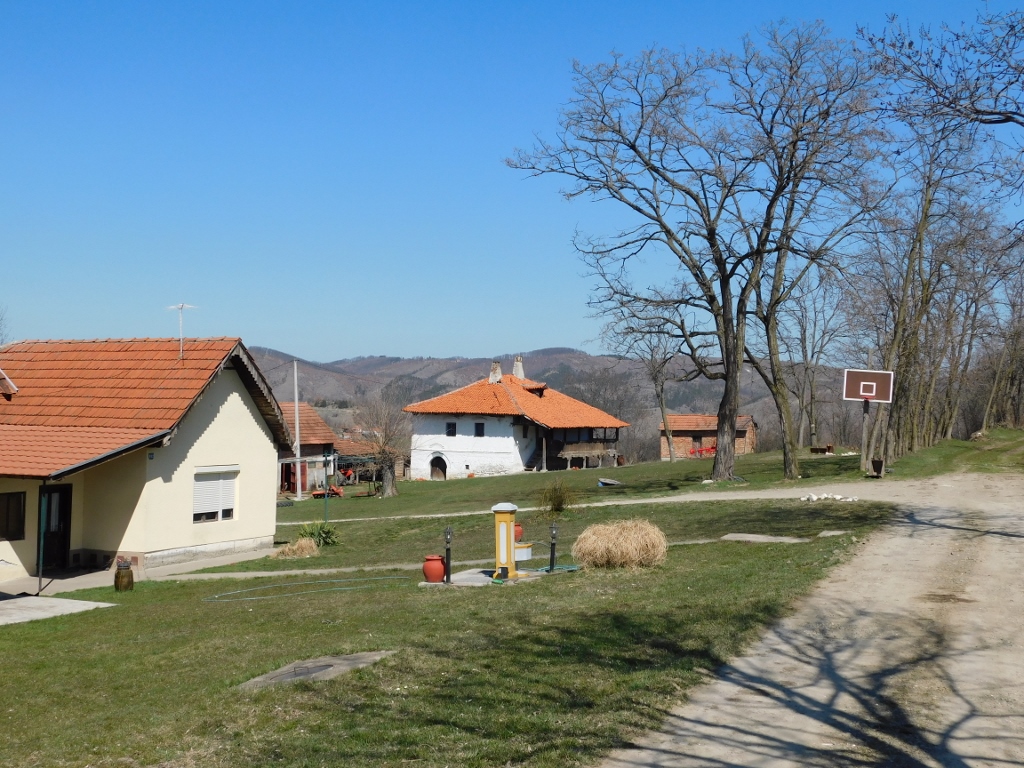 Approaching the holding; the House of Lužanin is in the middle
Approaching the holding; the House of Lužanin is in the middle
The residential part is built above the cellar and it is entered via a fenced porch. The house is covered with Monk and Nun roof tiles and the roof has very accentuated eaves above the fenced porch.
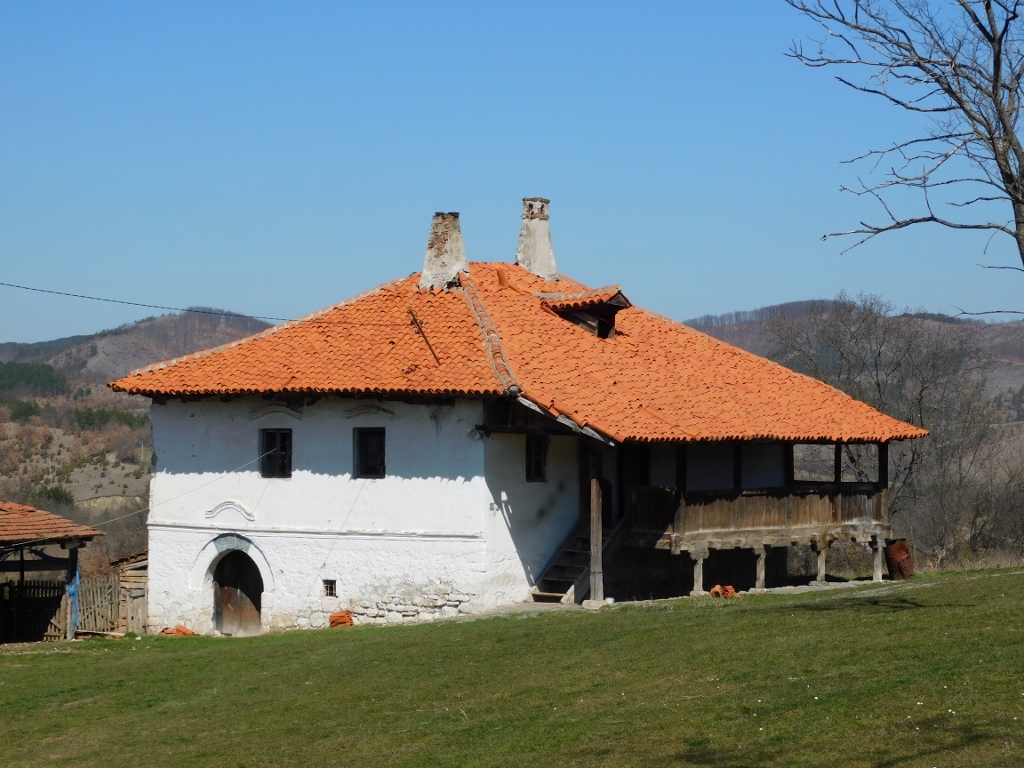 House of Lužanin
House of Lužanin
The house was built in 1861 by Lazar Lužanin and his two brothers, Aleksije and Jevrem, and this has been chiselled into stone placed as a part of the arched lintel above the cellar door.
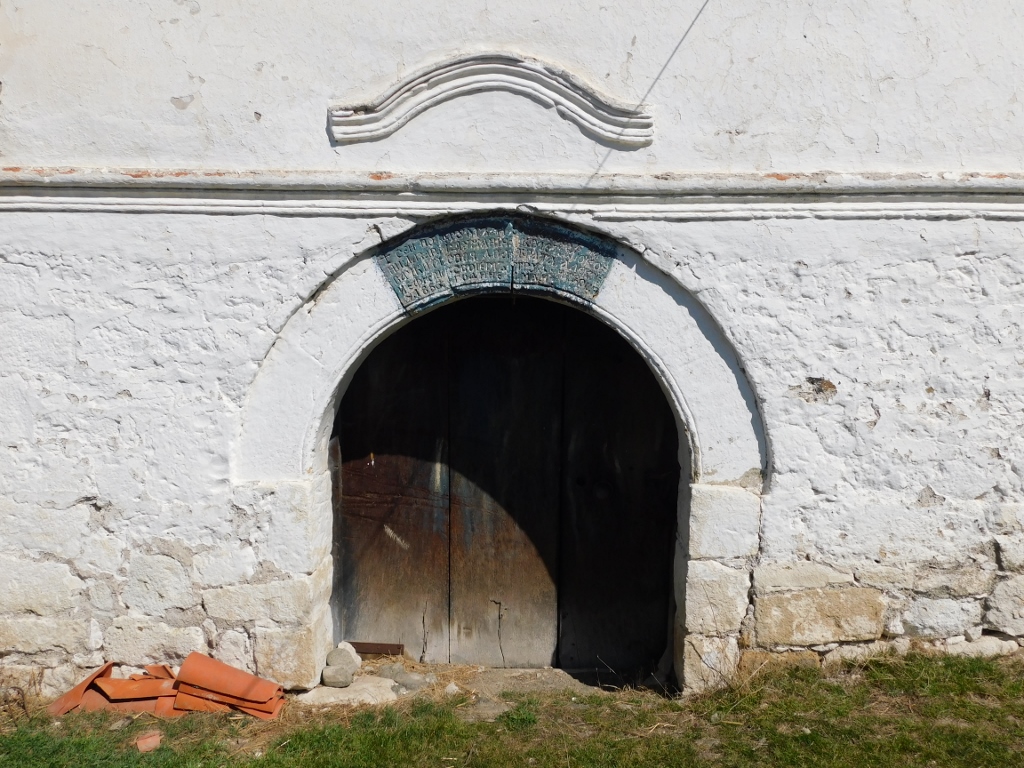 House of Lužanin, cellar door
House of Lužanin, cellar door
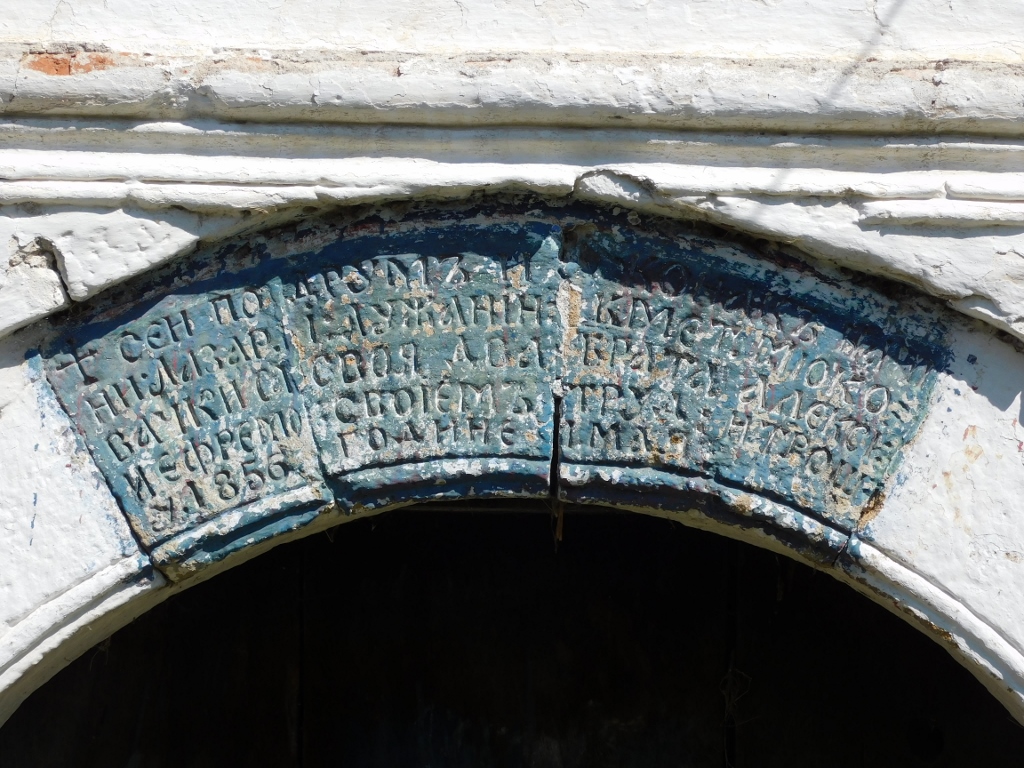 House of Lužanin, cellar door, a detail
House of Lužanin, cellar door, a detail
By the way, when I first got here, a small dog from the holding came running to me, but its only ambition was to be friendly. Still, since it barked a couple of times, a woman came out of the main house of the holding, I presented myself and said I only came to see the old house, so she let me do my thing, while she went back to continue doing her things.
I also noticed a very pretty granary on the estate while walking around. Although I certainly used to see them before, ever since my St. James’s Way in 2018 when I walked past numerous beautiful granaries in Galicia, I started to pay much more attention to this type of structure wherever I travel.
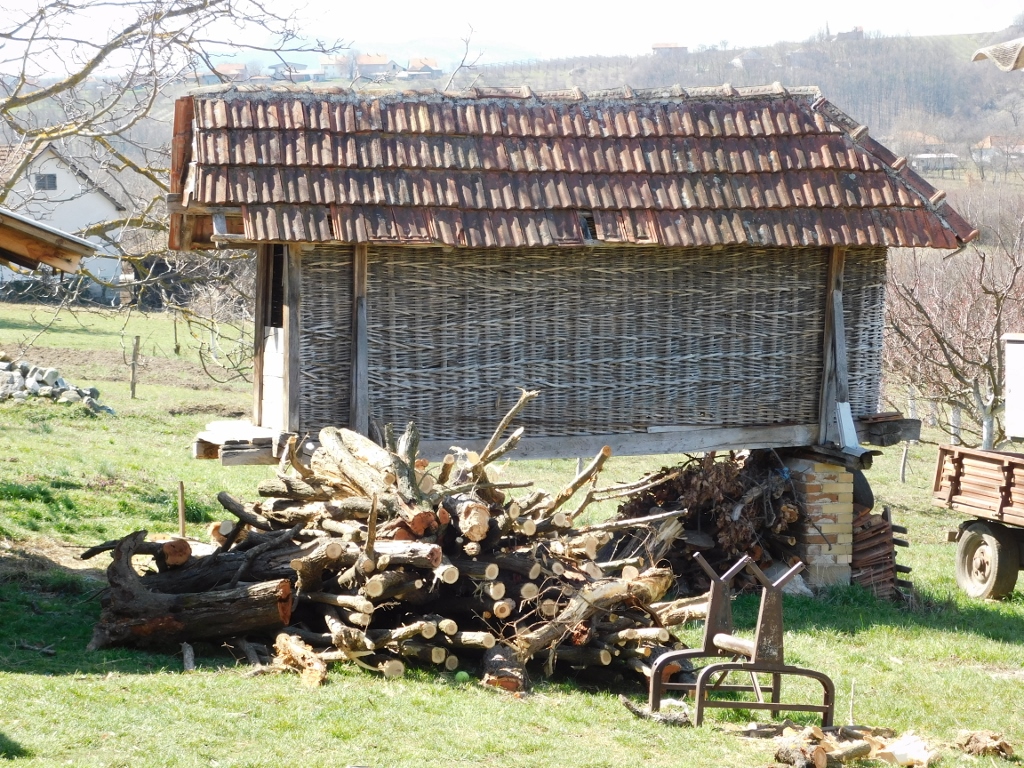 Granary on the same estate where the House of Lužanin is
Granary on the same estate where the House of Lužanin is
Then, I drove back to the main road, turning this time in the opposite direction in comparison to where I first came from, in order to get to yet another cultural property and this was the Church of the Intercession of the Holy Virgin, also in village Miokovci.
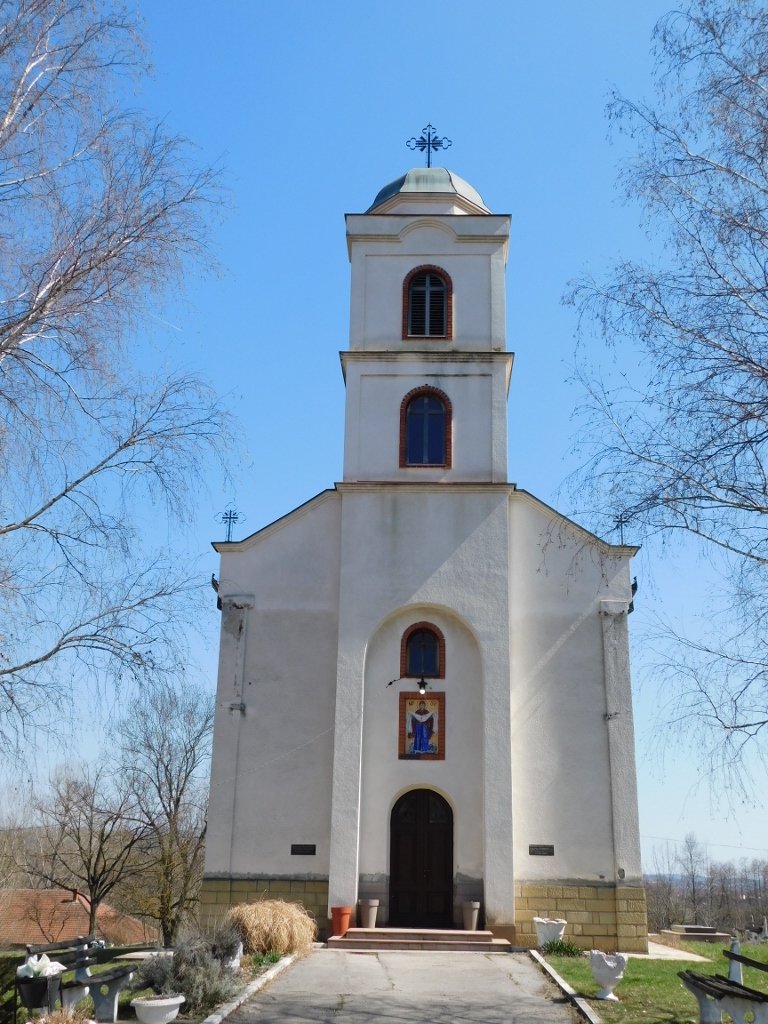 Church of the Intercession of the Holy Virgin
Church of the Intercession of the Holy Virgin
This church was built in 1890, although there used to be in this place an older church that was built in 1815 as the endowment of Princess Ljubica honouring the victory of the Serbian army in the Battle of Ljubić, which is testified to by one of the plaques that can be seen on the front facade. Unfortunately, the church was locked, while there was nobody in the house located within the church yard, for which I presumed that it was used by the priest with his family. For this reason I could see the church only from the outside, although on the basis of the descriptions in the materials I had on me I could conclude that the interior seemed very interesting and with some beautiful icons including one from the 16th century.
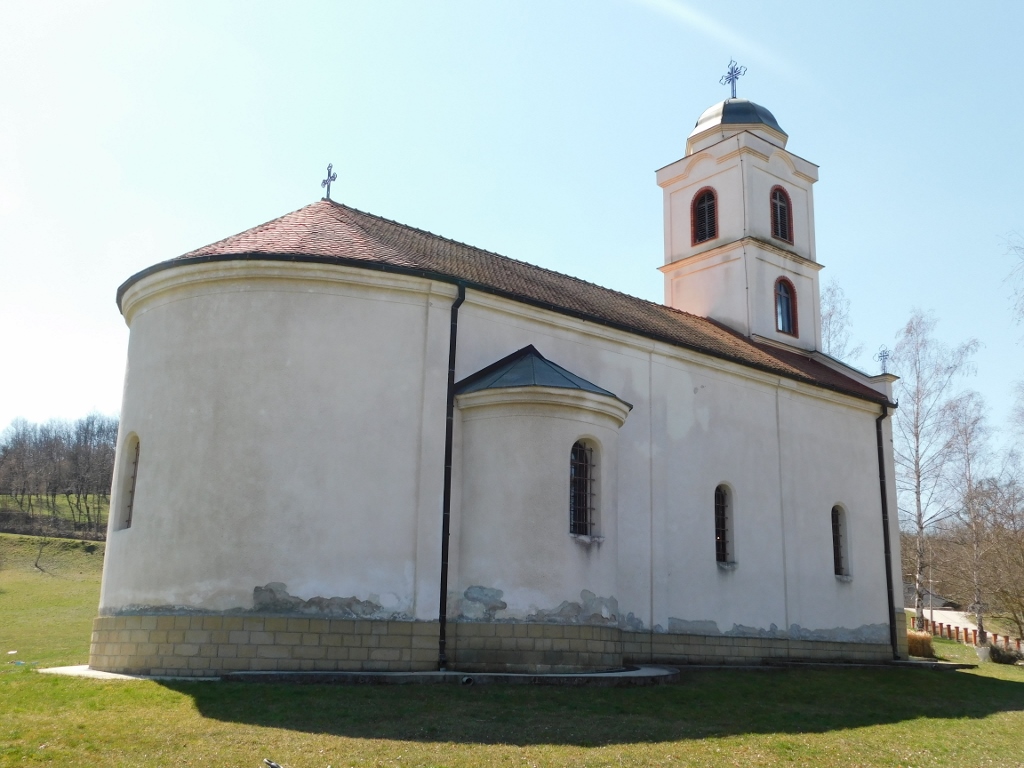 Church of the Intercession of the Holy Virgin
Church of the Intercession of the Holy Virgin
The church consists of a single nave, while the semi-circular choirs give it a three-conch ground plan. It is covered with beaver tail tiles.
There is a rather unusual gravestone in the church yard, unusual because of its bright colours, and it was ordered by the parents and a sister of a young soldier who died during WWI.
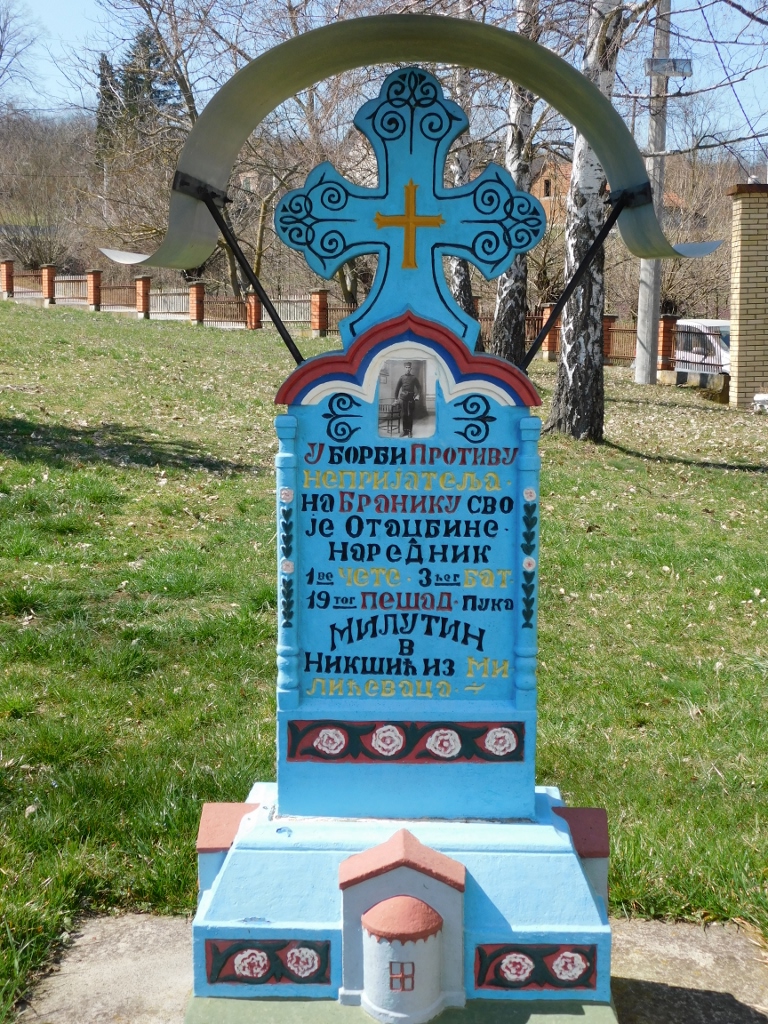 Gravestone in the yard of the Church of the Intercession of the Holy Virgin
Gravestone in the yard of the Church of the Intercession of the Holy Virgin
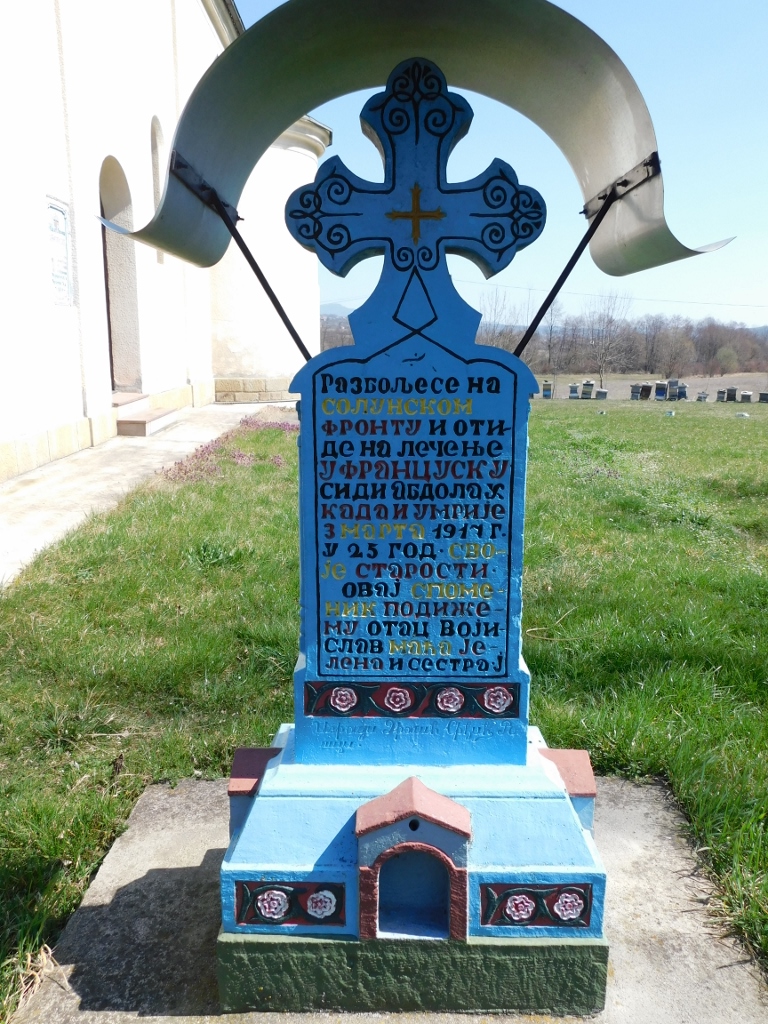 Gravestone in the yard of the Church of the Intercession of the Holy Virgin
Gravestone in the yard of the Church of the Intercession of the Holy Virgin
What I had to do now was to find yet another house, but in village Vranići. I had realised that the map I had was not quite good, so I stopped a couple of times along the way to ask for directions. At some point I realised I was not going the right way and I saw two men sitting by the road and drinking something from mugs. I stopped, opened the window, greeted them and wished them to enjoy whatever they were drinking, and then I asked them about my next destination. They started to explain, but I had to go back, so I said I would first turn the car and then they can tell me. When I did it, I realised they were actually sitting in a lovely spot with a wonderful view. So, I got out of the car and told them jokingly that they were not “naive” at all when they were making a break right there (I guess they worked the surrounding orchards) and I felt like enjoying the view myself for a short while. One of them offered home-made juice to me which he poured into a mug like the ones they were using. How could I say no?
Eventually, they explained how I could get to the House of Čolić, I thanked them and soon I was where I wanted to be.
The House of Čolić (Čolića kuća) in village Vranići near Čačak is a monument of culture and it was built in 1864.
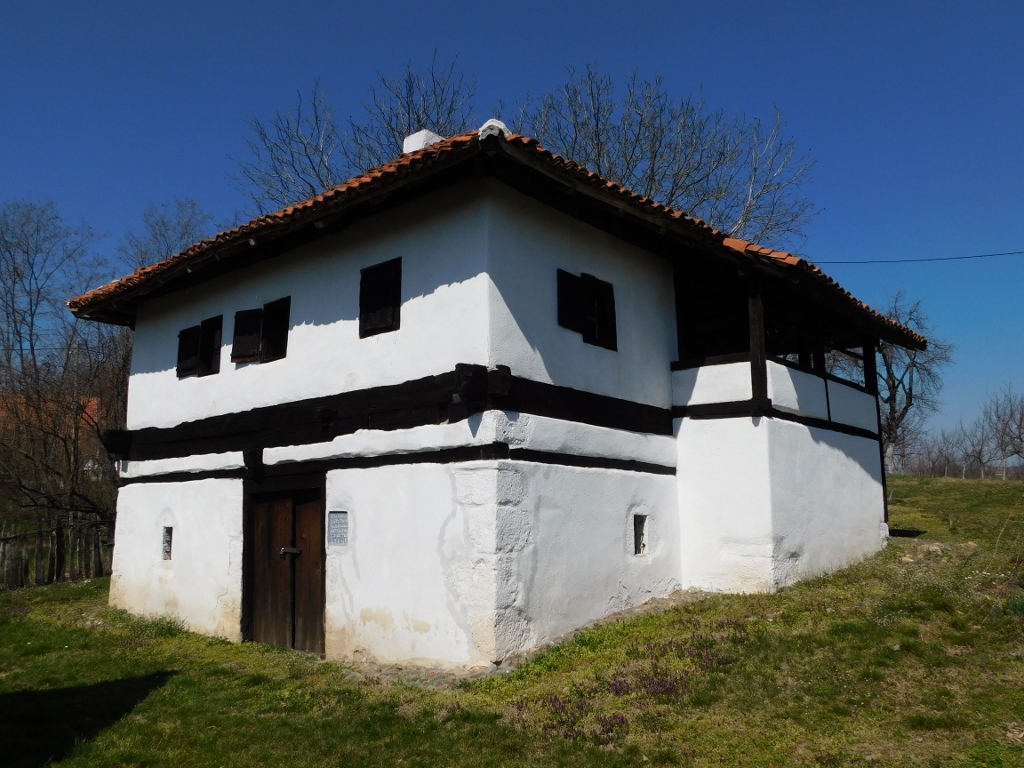 House of Čolić
House of Čolić
The cellar was made of stones and the floor of wooden beams (half-timber style), but the whole house has been plastered and whitewashed.
What is very interesting here is that around this house there are also old auxiliary structures, while the agricultural holding also incorporates more modern houses which the present owners live in or use. Moreover, the people I asked for the instructions as to how to get there said that this was a museum. Maybe not in the real sense of meaning, but it seems that the people in the village see this as an open-air museum since it illustrates the way people lived in this area around the middle of the 19th century.
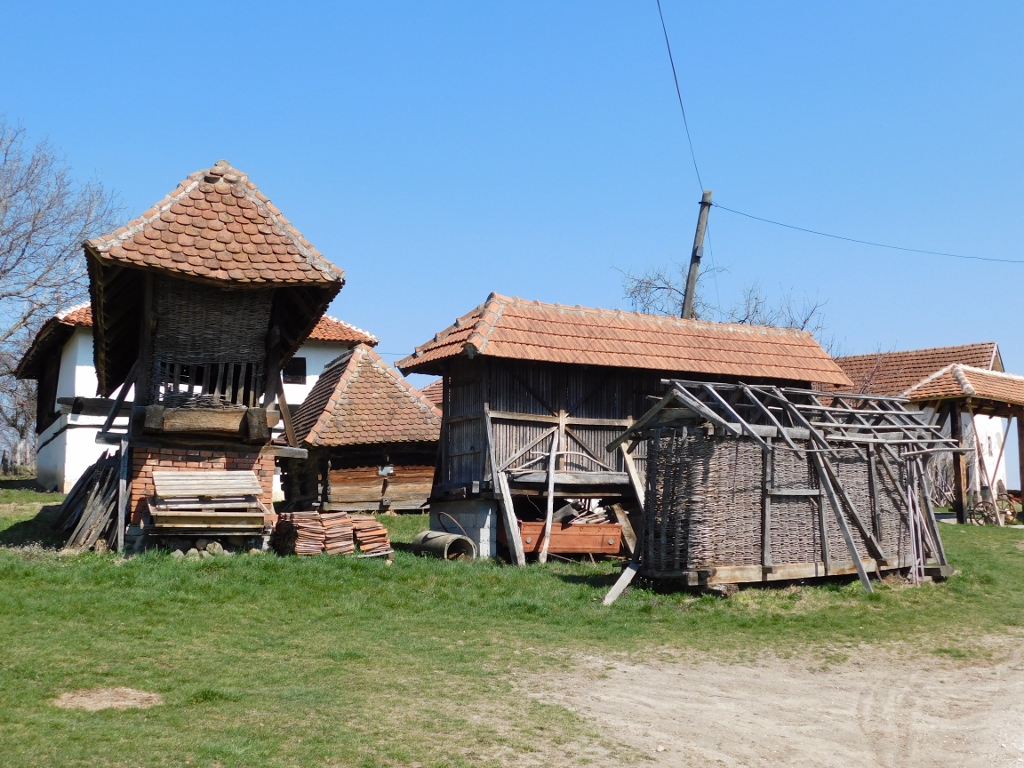 Structures around the House of Čolić
Structures around the House of Čolić
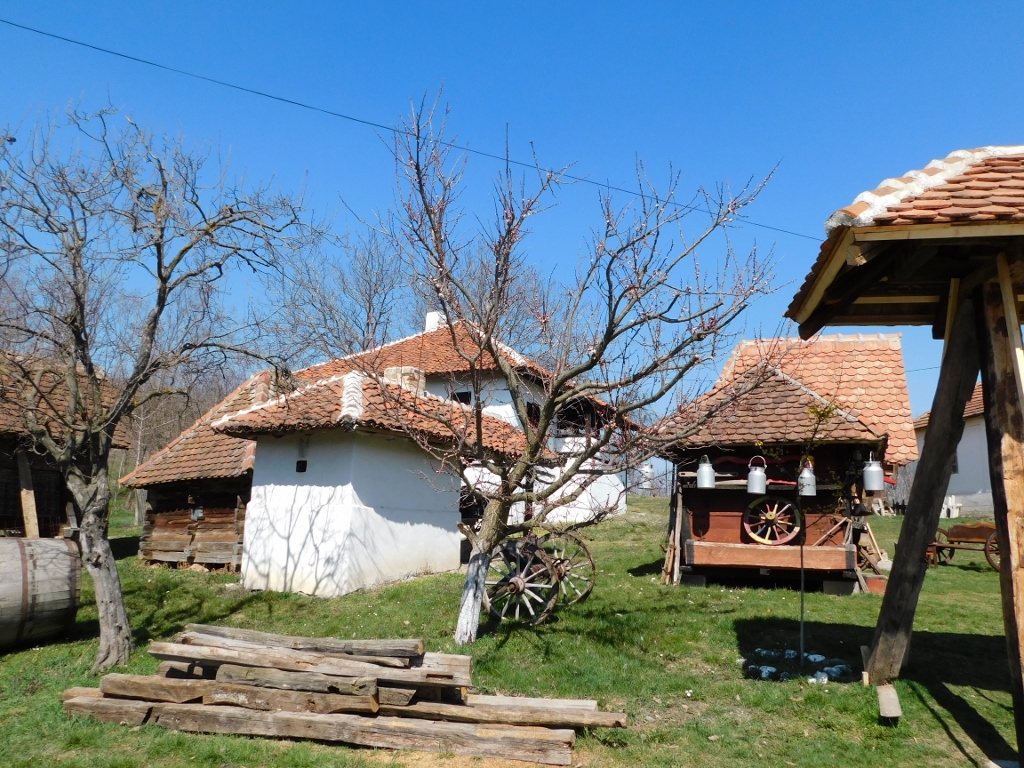 Structures around the House of Čolić
Structures around the House of Čolić
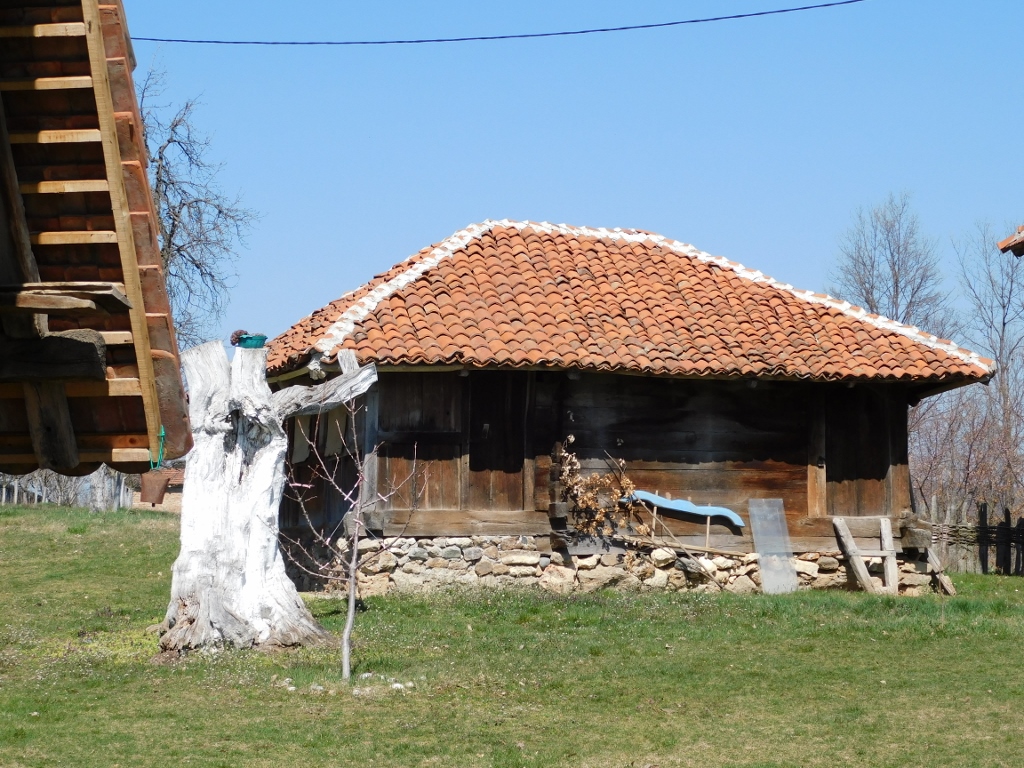 Structures around the House of Čolić
Structures around the House of Čolić
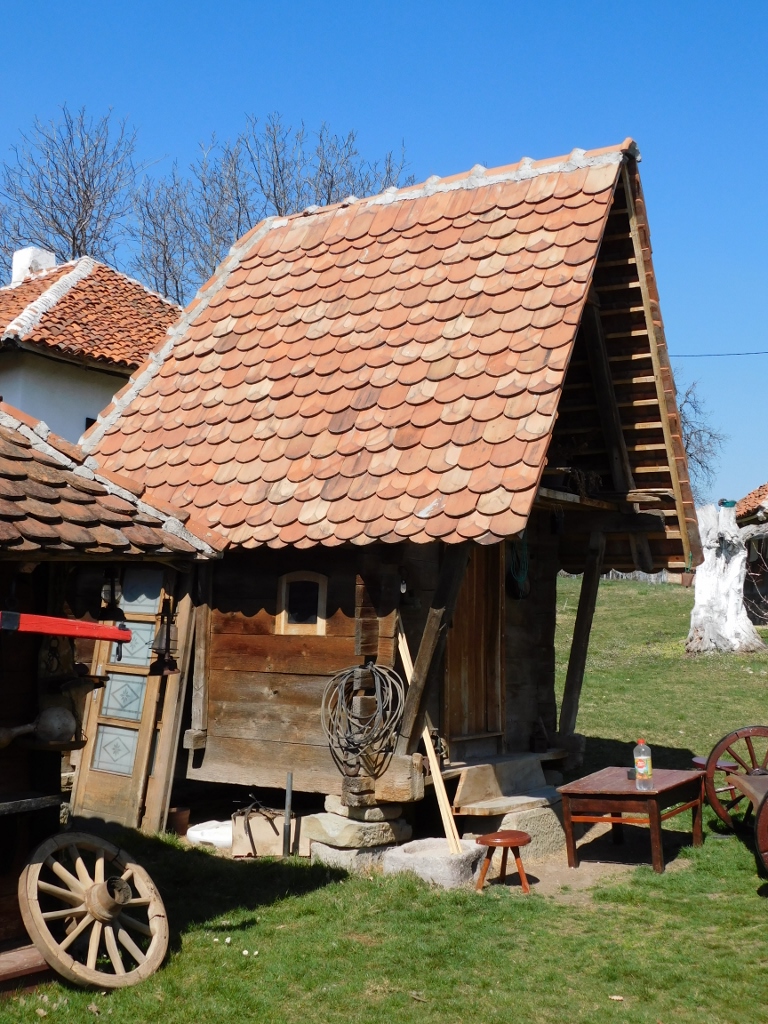 Structures around the House of Čolić
Structures around the House of Čolić
And now I could leisurely continue to yet another cultural property I wanted to visit which is closer to the centre of Čačak. However, my car started to act weird again (as if it suddenly boiled over), although it still drove well after I would turn off the engine for a short while. That’s why I decided to go directly to that automobile repair shop I have mentioned before. And so I did, leaving the car there, while I went for a coffee at a restaurant across the street. In an hour and a half, my car was repaired and ready for the continuation of the sightseeing and the return home.
So I went back to the Memorial Complex on Ljubić Hill, which is cultural heritage of exceptional importance.
Ljubić is the name of a hill, as well as a village north of the centre of Čačak. This is the place where in 1815 the biggest and the most important battle of the Second Serbian Uprising (against the Ottoman Empire) took place. The battle ended with the victory of the Serbian forces and that allowed the beginning of the restoration of the statehood of modern Serbia, but the first step was to negotiate with the Ottomans the autonomy of the Serbian population.
Tanasko Rajić, a great Serbian hero and one of the commanders of the uprising was killed in this battle. For this reason, in 1938, a monument was erected on Ljubić Hill honouring Tanasko Rajić and other fighters who laid their lives here.
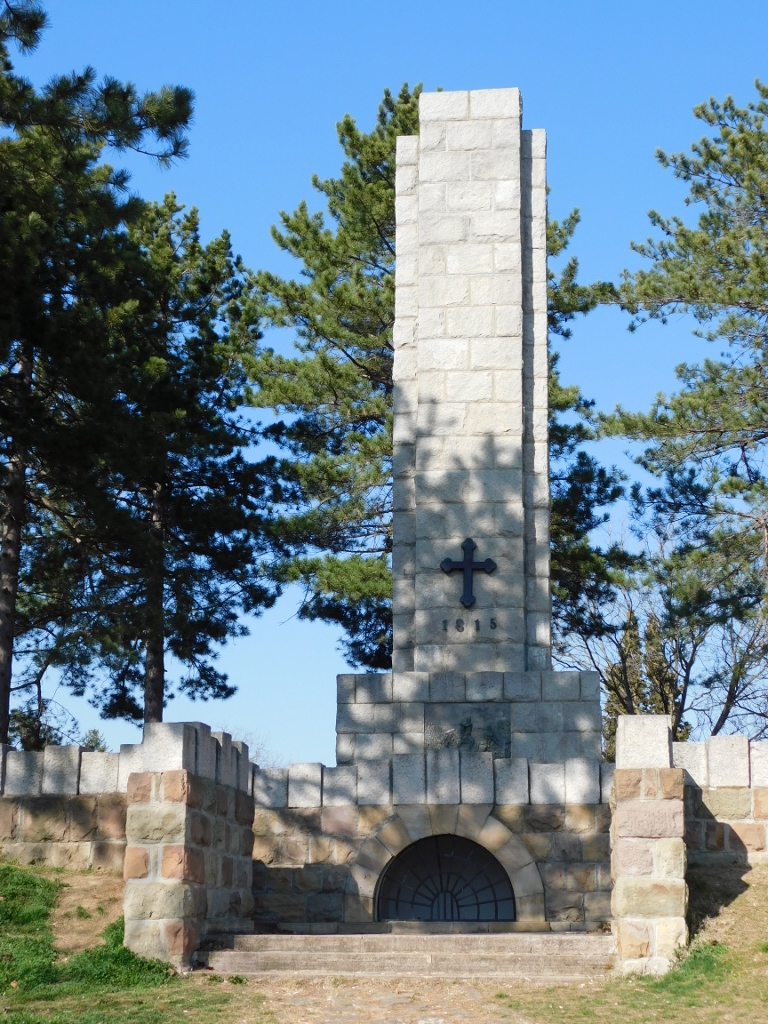 Monument on Ljubić Hill
Monument on Ljubić Hill
The monument is simple, like an obelisk, and on its front side, in addition to the cross and the year, there is also a bronze plaque with the depiction of Tanasko Rajić getting killed while defending a cannon.
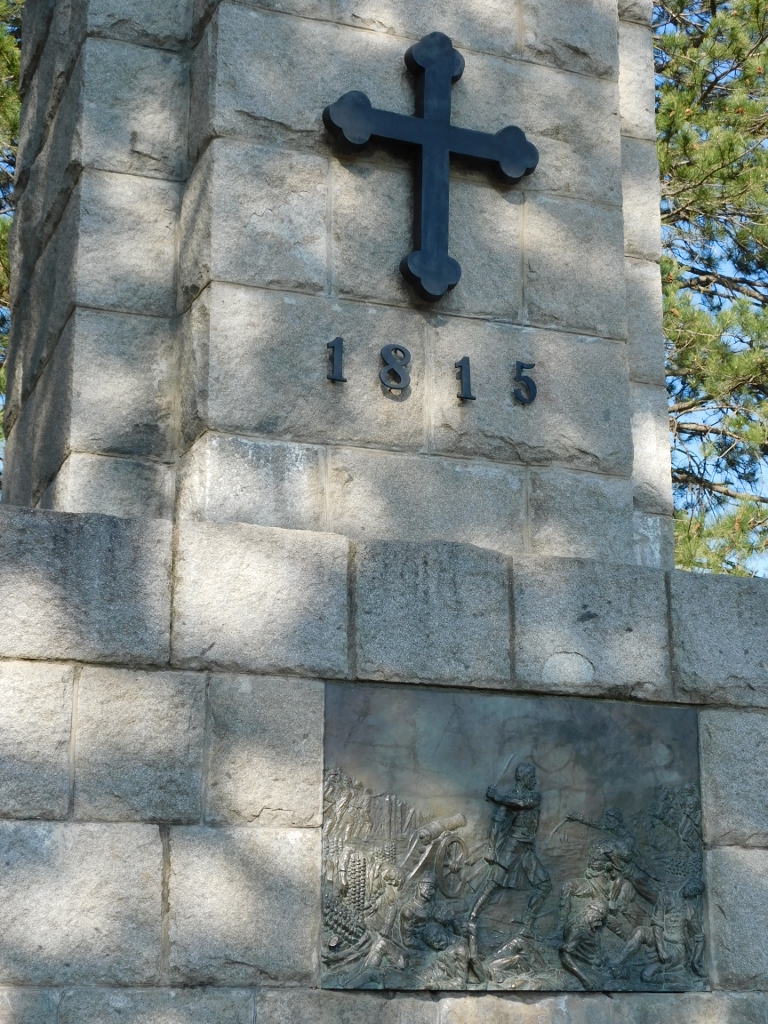 Monument on Ljubić Hill, a detail
Monument on Ljubić Hill, a detail
In addition to this monument, the complex also incorporates large tombs of different soldiers killed during WWI and WWII.
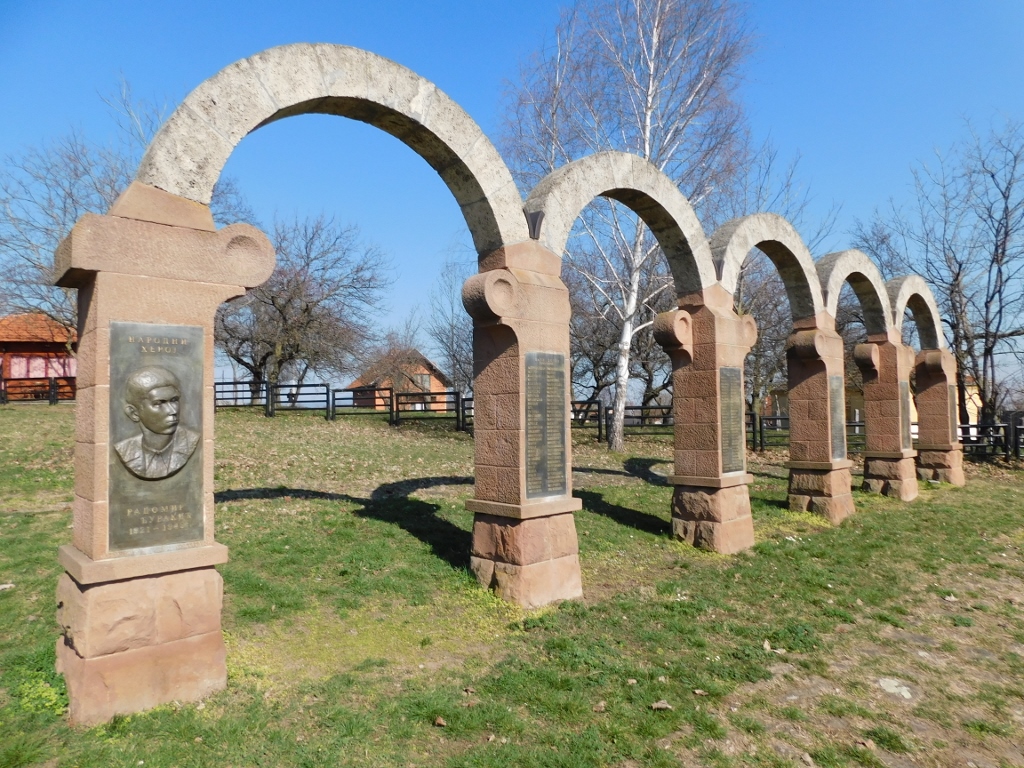 Memorial within the Memorial Complex on Ljubić Hill
Memorial within the Memorial Complex on Ljubić Hill
There is also a newly-built church dedicated to Holy Prince Lazar (of Serbia) and all Serbian martyrs. The construction started in 2003, while the church was consecrated in 2013.
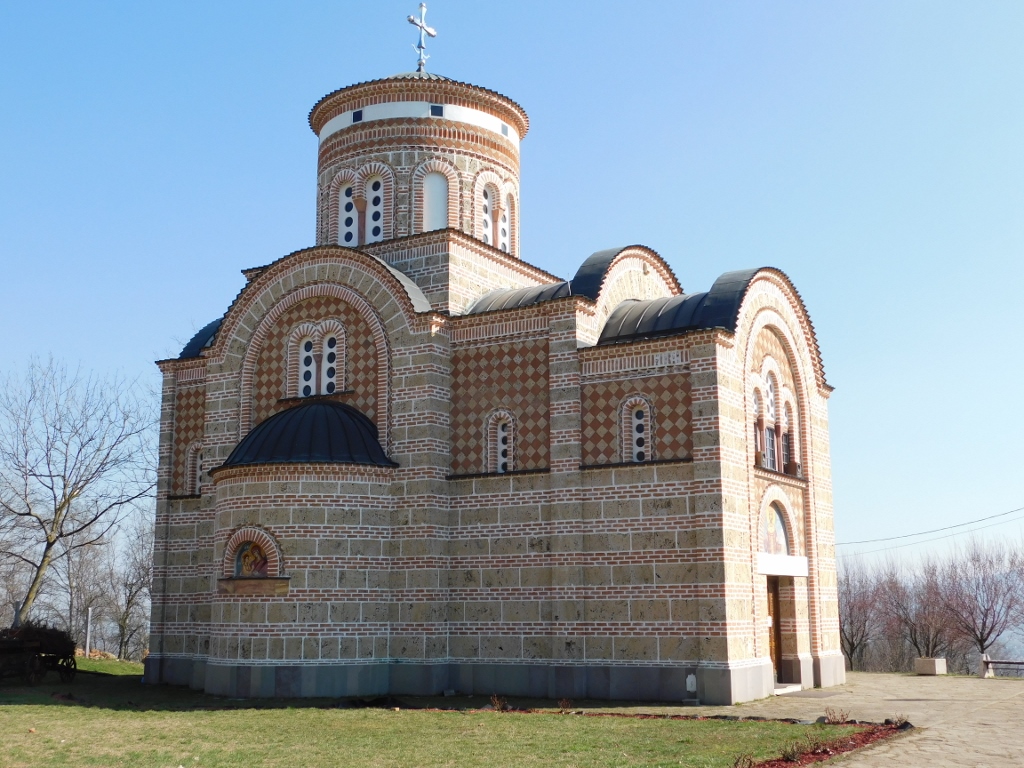 Church of Holy Prince Lazar within the Memorial Complex on Ljubić Hill
Church of Holy Prince Lazar within the Memorial Complex on Ljubić Hill
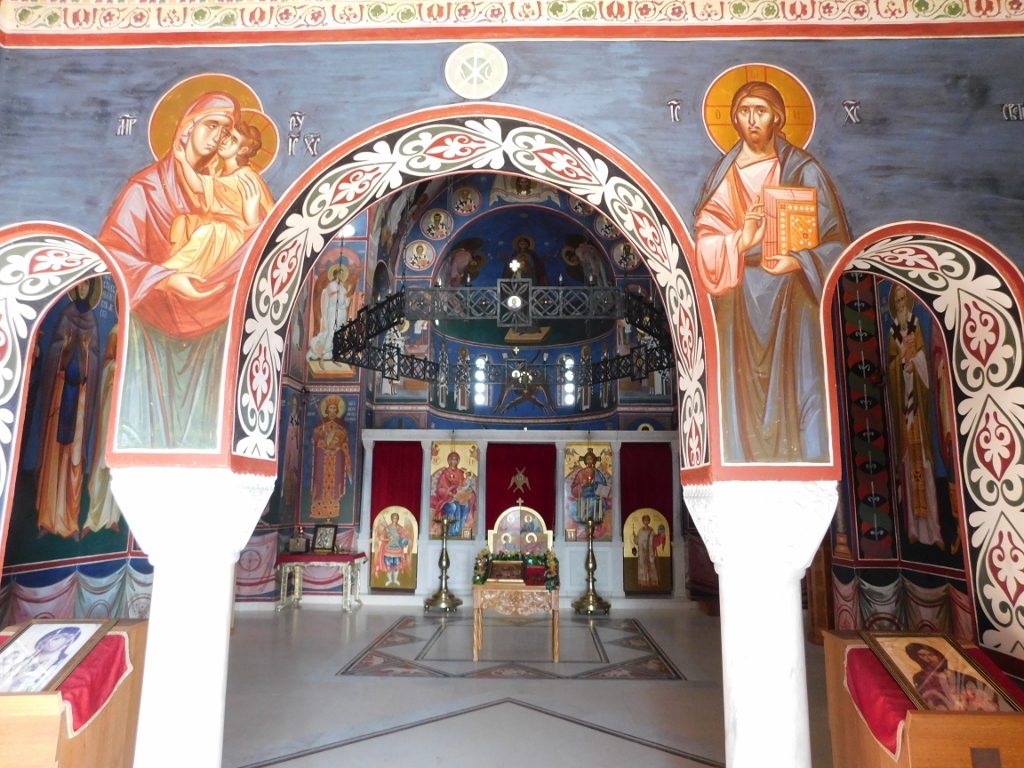 Church of Holy Prince Lazar, a detail
Church of Holy Prince Lazar, a detail
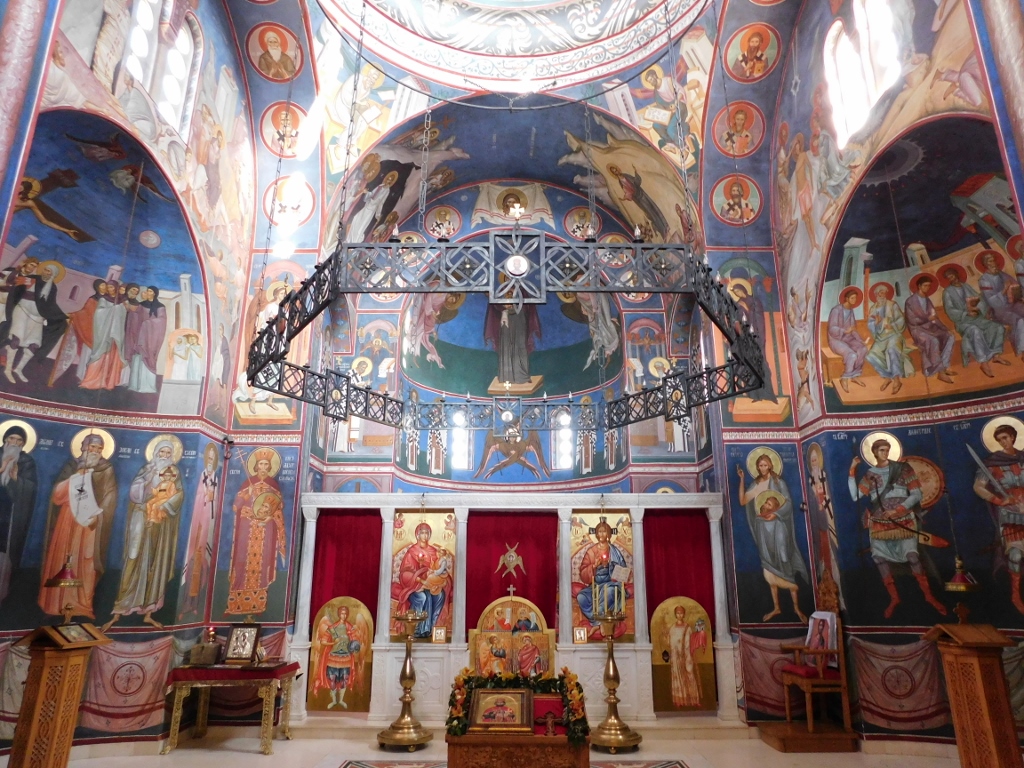 Church of Holy Prince Lazar, a detail
Church of Holy Prince Lazar, a detail
When I came out of the church, I enjoyed a little while more the wonderful view from here.
 View at Čačak and the surroundings from Ljubić Hill
View at Čačak and the surroundings from Ljubić Hill
Of course, there were also mountains Ovčar and Kablar (in the upper photo, in the distance to the right).
 View at Ovčar (left) and Kablar (right) that I walked across during the previous couple of days
View at Ovčar (left) and Kablar (right) that I walked across during the previous couple of days
Here I finally finished with my sightseeing around Čačak and Ovčar Banja in March 2022, so I got into the car and headed for Belgrade. I opted again for the road called Ibarska magistrala among other reasons also because I wanted to make a stop at yet another interesting place.
This is an estate that belongs to the Family of Clear Streams (Porodica bistrih potoka). Back in 1977, when the ecology and return to nature were still not a question of fashion and contemporary trends, a family from Novi Sad with small children moved here and started to live like that – ecologically. I have heard about them a long time ago and several years ago I visited them as a part of one of my work engagements. I was interpreting for a yoga master who came to Serbia in order to lead a seminar and within that seminar there was also a day trip to this place. It was multiply interesting experience.
This time around, however, there was nobody, but I entered the open yard anyway and took a few photos. Whoever is interested in this place, can find a Facebook group under the same (Serbian) name as the family.
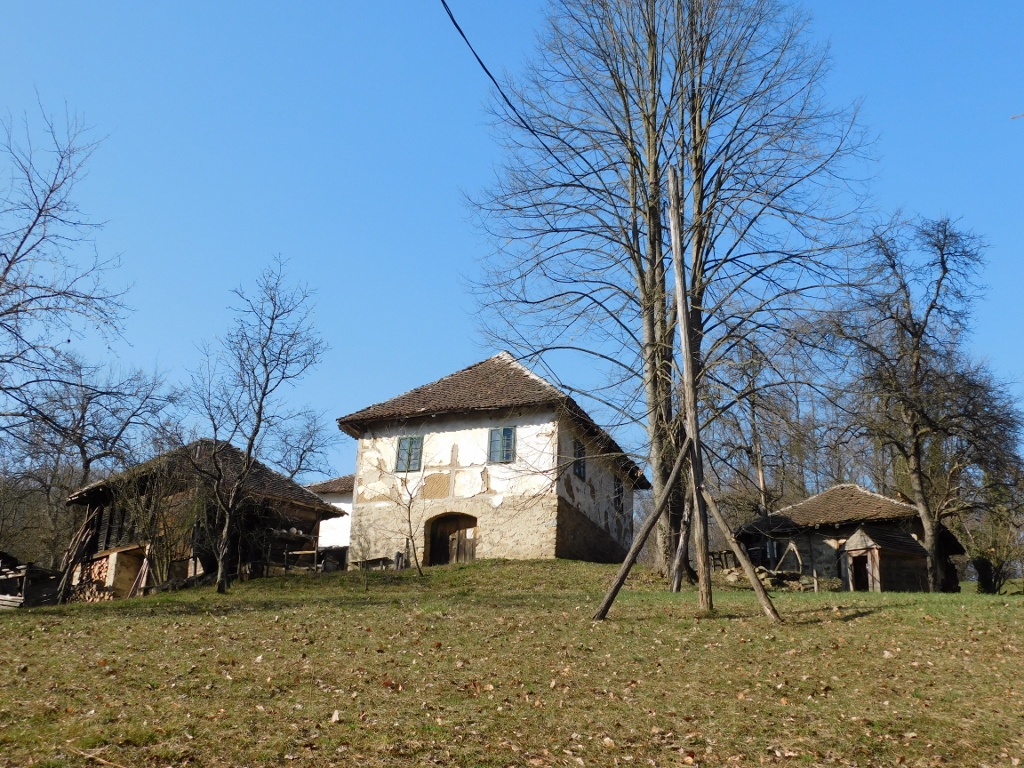 Estate of the Family of Clear Streams
Estate of the Family of Clear Streams
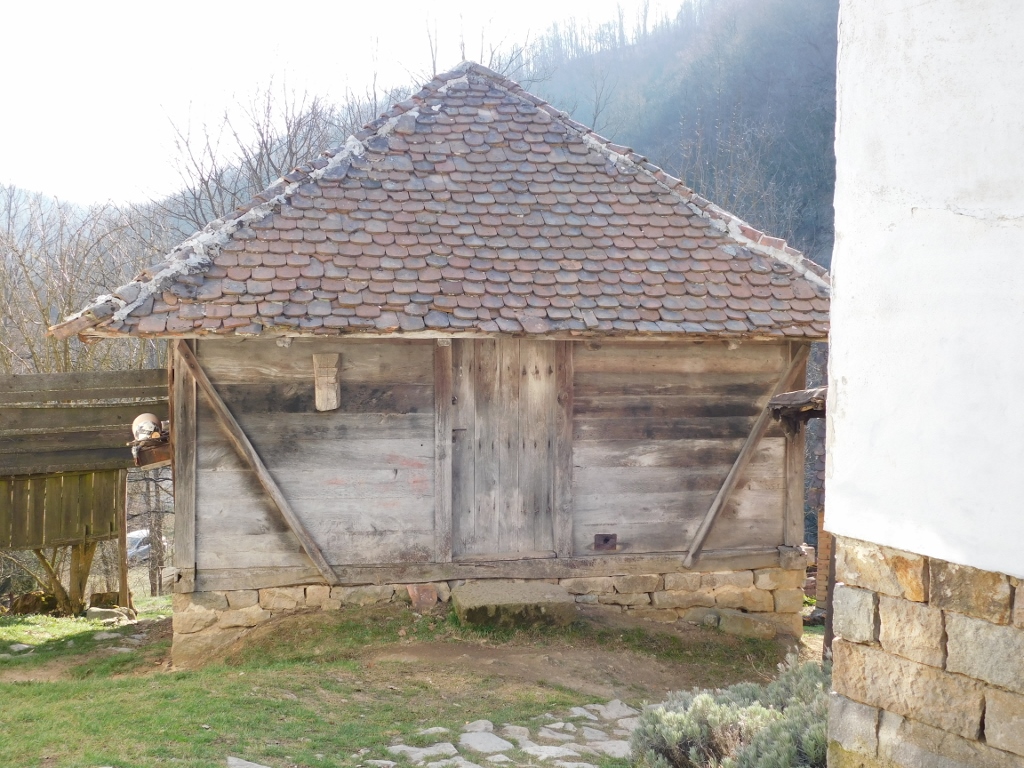 Estate of the Family of Clear Streams
Estate of the Family of Clear Streams
 Estate of the Family of Clear Streams
Estate of the Family of Clear Streams
As for me, I got back to my car, drove along the Ibarska magistrala for a short while, then moved on to a motorway and soon I was home. Very content!